Back to Home Page
Download the PDF of Jazz Turnarounds.
![]()
![]()
![]()
![]()
![]()
![]()
![]()
![]()
![]()
![]()
![]()
![]()
![]()
![]()
![]()
![]()
![]()
![]()
![]()
![]()
![]()
![]()
![]()
![]()
![]()
![]()
scroll down for Vandercook Masters Project
Improvisation on the
ii-V7-I
and
Blues Progressions
David J Rice
Masters Project
Completed in partial fulfillment of the degree Master of Music Education
VanderCook College of Music
July, 2008
_____________________________________
Michael Pendowski - Date
Abstract
Improvisation on the ii-V7-I and
Blues Progressions
David J. Rice
991 Bankfield Ct.
Naperville, Il. 60540
This paper is method of study for the beginning music student who desires to learn to improvise on his/her instrument in a jazz or blues idiom. This study of jazz improvisation utilizes the following paper with 2 accompanying CDs and the website www.davericeproductions.com. I chose to add the website for those students with access to a computer or web browsing device who may not have a stereo system at their disposal. They may access all of the audio tracks which accompany the lessons on the website.
This study will also establish that with the early student the ii-V-I progression and blues progression are the most important progressions to begin with. There are variations of the ii-V-I progression which will be explored also in this study. Each chord progression, scale, chord voicing, arpeggio, and melody which is assigned may be practiced with a slow, medium, and fast audio track to allow the student to gain proficiency.
This study includes several written music examples all of which have been written for concert instruments, Bb instruments, Eb instruments, and F instruments. They have been written in such a way that the student may play his/her instrument reading the appropriate transposed score and it will match the audio example which accompanies. The student may simply log on to the website www.davericeproductions.com, enter the main page, and then enter the section entitled jazz improvisation.
Introduction
Statement of the Problem
The study method I have created includes a written text with illustrations and audio CDs, as well as the website www.davericeproductions.com .The student learns improvisation beginning with simple melodies played over ii-V-I chord progressions. Each step in learning to play melodies and harmonies is accompanied with slow, medium, and fast audio recordings to allow the beginning student to start slowly and gain confidence and proficiency. As the student becomes familiar with one level they advance to more complex melodies, scales, and chords. This method may be used by the beginning elementary student and the more complex scales and harmonies may be used by the junior high and high school student.
At this juncture I should mention that I have studied piano since the age of 6 and played in bands since the age of 10. My first paid job was in Junior High School. My friends and I took our rock n’roll band and played for a nighttime dance for students in the “Happy Day” Home for children with mental deficiencies. We earned $5 each. Since that day I have always played in at least one or two bands at a time. Upon beginning my college undergraduate education I found I could make a decent part time living while in school by playing jobs with other music majors. After graduation, I immediately went on the road with several diverse groups ranging from jazz, pop, disco, blues, rock n’roll, funk, country, and show music. I had already been practicing ii-V-I chord progressions for several years when Jamie Abersold came to give a clinic to our jazz band at SIU, Carbondale. I have an immense respect for the instruction and knowledge that he and others have given to our modern day music field.
I presently teach elementary school in Valley View District 365-U in Romeoville, Il. Improvisation is not contained in our elementary curriculum yet, but I believe it is an important part of a well rounded music curriculum. In the national achievement standards for elementary grades students are asked to “improvise melodic embellishments and simple rhythmic and melodic variations” (Improvise, n.d.). In the Illinois state standards 26B Stage D #10 students are expected to “Improvise simple rhythmic variations or simple melodic embellishments”. In 26 B Stage F students are asked to “Improvise original melodies over given chord progressions” (Standards, n.d.).
My problem simply is this: I need a system of instruction for music improvisation that is free for all students, accessible to all students, and that includes audio tracks for students to practice with even if the students cannot afford a stereo CD or tape player. I need this system of instruction to include the melodic and harmonic use of ii-V-I and blues progressions and to include the use of scale tones in the dorian and mixolydian modes as well as other modes. The instruction should become more complex and advanced as the student gains proficiency making it useful for junior high and high school as well. Creating an instructional website of my own as well as a hard copy package with CDs fills this need directly. I did not find any websites offering a free and complete system of instruction from beginning to end in jazz and blues idioms. While many authors have written fine books for the high school and college level student, their beginning point is too high for my 3rd grade students who are beginning the recorder for the first time in their life. My goal in this project is to provide a free website available to any student giving them a beginning method of learning to improvise starting from the simplest melody which will fit over a ii-V-I chord progression and advancing to more challenging scales and arpeggios.
After surveying several jazz theory books by such excellent authors as Jamey Aebersold, Dick Grove, Mark Levine and others, I have found that there is not a great deal of instruction in improvisation for the beginning elementary student. Additionally, I learned that the elementary improvisation techniques of authors such as Kodály, Dalcroze, and Orff often explore early melodic and harmonic improvisation based on sol to mi over harmony which is largely played over the I major chord. These methods also utilize improvisation over ostinatos based on a simple major pentatonic scale or with Kodály sometimes over a minor pentatonic scale.
I must emphatically state that this project in no way intends to diminish or criticize the excellent contributions and of such great educators as Kodály, Gordon, Dalcroze, Aebersold, Levine, or others. I also do not recommend replacing any program of instruction with the one set forth in this project. This author wishes only to add to the already available materials and fill in certain areas useful to young elementary students.
In her book “The Eclectic Curriculum in American Music Education: Contributions of Dalcroze, Kodály, and Orff”, Beth Landis writes,
One of the three basic areas of experience in the Dalcroze plan is improvisation at the piano. The goal of piano improvisation is to give the same freedom at the instrument that students have in whole-body responses to music. This freedom is developed, in part, by assigning exercises in extemporaneous playing, which are performed in a given tempo and carried out at a brisk pace that does not allow for self-consciousness or negative attitudes…In one exercise four pitches such as C, D, E, F-sharp are given. As the teacher plays a harmonic background, students, in turn, sing an improvised rhythmic pattern of two measures using any two of the four pitches (Landis, 1972, pp.26-28).
Of course these wonderful authors have included years of instruction over the I major chord and pentatonic scale. But because many folk songs and traditional songs have been passed down through generations, over time they have changed from what was once a minor pentatonic sound in the early Hungarian music of Zoltán Kodály to Europeanized major minor music using sol to mi melodies avoiding the harmonic movement from the minor chord ii which uses the dorian mode incorporating a minor third above the root of the ii-re, mi, and fa syllables to the major chord V which uses the notes of the mixolydian scale- syllables sol, la, and ti is avoided. By avoiding the syllables of fa and ti which form a tritone we also avoid the harmonic tension and release of this forward moving ii-V-I chord progression. To be accurate, Zoltán Kodály did develop the “sol-fa” system. “Kodály called his method sol-fa teaching, a name derived from the Tonic Sol-fa system used in England after about 1840 by John Curwen…Unlike Dalcroze and most other European teachers, Kodály used the moveable do system of solmization…( Landis / Carder, 1972, pp. 44-45)”.
In the book, “The Selected Writings of Zoltán Kodály”, on pp.11-23 Kodály writes,
Its structure. The Hungarian pentatonic scale is a natural (or descending “melodic” minor) scale from which the second and sixth degrees are missing. If, for example we choose G for the tonic, the scale is: G-Bb-C-D-F… the widest possible range is: F-G-Bb-C-D-F-G-Bb and the narrowest is: G-Bb-C-D…
Relationship between pentatony and the major-minor system. In view of the fact that even our villages have long been overwhelmed with music in major and minor keys, it is surprising that the pentatonic system survived in a completely pure state, even if only in a dozen or so examples…Songs belonging here can be classified in four groups. 1. Purely pentatonic. 2. Songs in which the two missing notes appear here and there as transitional notes or grace notes. 3. Songs in which the notes outside the system are given a separate syllable…4. Songs in which some phrase of the melody point to a pentatonic origin, but in which the influence of the major and minor, the tonic dominant relationship , has more or less obliterated the basic pentatonic structure…In the Transdanubian region, the old system fights the new in a peculiar way. It is no doubt the effect of the major scale that old songs of a purely pentatonic structure may be heard with the third higher and seventh higher. This height sometimes reaches that of the major scale, so that we seem to be dealing with a purely major song (Kodály,1964, pp.20-22).
David Baker’s “Jazz Improvisation, a Comprehensive Method for All Musicians” starts with major scales played from the lowest note on one’s own instrument to the highest note. He then writes arpeggios of every jazz chord in all 12 keys.
On page 1 of his book David Baker gives a concise explanation of major and minor triads as follows:
One of the first things that an aspiring jazz musician must do is learn to read and interpret chord symbols. The six chord types are major, minor, dominant, diminished, augmented, and half diminished.
An alphabetical letter indicates the root on which a chord is built. The tertian system is usually employed , that is, chords are built in consecutive thirds (i.e., C-E-G-B-D-F-A). For the uninitiated two shortcuts to aid in chord construction follow: (1) build the chord using alternating letters of the musical alphabet (i.e., F-A-C-E-G-B-D-etc. A letter standing alone usually indicates a major triad which is a chord consisting of the root, the major third, and the perfect fifth, i.e.,C-E-G-,F-A-C-,Gb-Bb-Db, etc (Baker, 1979, p.1).
In the world of jazz and blues improvisation there are two chord progressions that stand alone which are used by professional and non-professional musicians in practice and in actual application more than all others put together. These are the ii-V7-I progression with its variations and the blues progression with its variations.
Mark Levine states his guide “The Jazz Theory Book”,
“There are lots of chord progressions, but ii-V-I is the most common chord progression jazz musicians play. The original source of the ii,V, and I chords are the modes of the major scale…Think of the modes this way: The C major scale has seven different notes, and you can play the scale starting on any one of its seven notes. This means that there are really seven different C major scales- one that starts on C, one on D, one on E, one on F, and so on through B. Each mode has a Greek name, shown to the right of the mode. The Roman numerals I through VII shown to the left of each mode correspond to the modal name on the right- I is Ionian, II is Dorian, III is Phrygian, and so forth. This is the same in every major key.
Greek modal names are not esoteric; they are everyday terms that jazz musicians use…From the modes come seventh chords. Seventh chords are constructed by playing every other note of each mode.
The I, ii, and V chords often occur as a ii-V-I chord progression, the most common chord progression played in jazz. (Levine,1995, p. 15-19)
He continues,” I was fortunate to have some great teachers. A New york jazz pianist, Joe Pace, introduced me to the beauty of the II-V-I progression. I spent two years studying with the great Jaki Byard, followed by a year with Hall Overton, who knew more about Thelonious Monk’s music than anyone else at that time, and was a profound and caring teacher (Levine,1995, p.v).
The great jazz educator Jamey Aebersold starts his book “Turnarounds, Cycles, and II/V7’s” with a turnaround exercise in which every other measure is a ii-V-I progression. He
uses the ii-V-I to change keys from C to Db. Db to D, and D to Eb. Mr. Aebersold writes,” In order to effectively lead to the second eight bars you should change keys on the 8th measure (II/V7) leading to the new major key of Db (concert).” (Aebersold,1979).
Method
I am currently a music teacher for two elementary schools – Irene H. King and Robert C. Hill Elementary Schools in Romeoville, Il. At one of these schools the percentage of financially needy students is 61%. The percentage at the other school is not as high but there is still a significant percentage of financially needy families. Often students cannot afford a stereo sound system on which to practice or use on a daily basis. These students do, however, often have computers available in their classrooms or their parents may have one computer at home available for use.
Therefore creating the website www.davericeproductions.com which was available to anyone at no cost made more sense than trying convince people to purchase an educational text study. This paper will explore the ii-V7-I chord progressions, and other related chord progressions. We will also study the blues progression. We will begin at an elementary level of practicing scales and chords and advance to more difficult levels step by step.
If you are a beginning musician you already have a little bit of ability to play on your instrument. We will begin by showing examples of chord progressions, and then explore how to play improvisatory notes over the progressions. At first you may think, ”This doesn’t sound like something I’ve heard”. Please allow us to show you how to develop these progressions, learn these scales, show alternate voicings, alternate progressions, and eventually you will be able to develop an entire vocabulary of improvisatory techniques to use in playing your instrument.
Extremely
Important: Rule #1
At this point in our study I would like you to get into the habit of practicing everything that you learn in all 12 keys on your instrument. Each time you gain a little snippet of information or learn a new solo riff it will feel like a blinder has fallen off your eyes and ears. You will most likely play this newfound riff in a song that you are practicing and be very happy to have it in that song. To truly imbed this line, chord structure, or riff in your grey matter you must now turn and practice in all of its applications in all keys.
Lesson 1:ii-V-I
We will start with the ii-V7- I progression. We are starting in the key of C major though it is important to keep in mind these principles can apply to the same chord progression in other keys as well. In the key of C major, a C major chord is the I chord. Roman numerals will be used to indicate the position of the chord on the major or minor scale. In C major we call the C –I; we call D minor –ii; we call E minor iii; we call F major IV; we call G major V; we call A minor vi; and we call B diminished vii°. In the I major chord there is a Major 3rd (4 half steps) between the root ( name of the chord) and the 3rd. There is a minor 3rd (3 half steps between the 3rd and the 5th. The following chart indicates the relationship in our beginning chords between the roots, 3rds and 5ths. M3 indicates Major 3rd; m3 indicates minor 3rd.
Root interval 3rd interval 5th
I C M3 E m3 G
ii D m3 F m3 A
iii E m3 G M3 B
IV F M3 A m3 C
V G M3 B m3 D
vi A m3 C M3 E
viiŅ B m3 D m3 F
In the ii-V- I progression we play D minor, G major, then C major. If you play guitar or keyboards play music example #1. Next, you should take example #1 and play it in all 12 keys. Before we begin, you should note that the 2nd chord in each example is in first inversion. This means that the 3rd of the chord is on the bottom which sounds smoother and makes the transistion between the other chords smoother.
Dan Haerle gives some really great tips for chord voicings for the pianist, guitarist, or vibraphonist.
In connecting chords , individual chord tones should move smoothly to a tone in the next chord, usually stepwise. Common tones between two successive chords may be retained or moved stepwise if a resolution causes duplication of a tone (Haerle,1974,p.iii).
Exercise 1a
Here is Music Example 1 in all twelve keys. You will notice that this corresponds to the Audio Ex.1 ii-V-I slow, Audio Ex.1 ii-V-I Medium and Audio Ex. 1 ii-V-I fast on the CD and website www.davericeproductions.com. If you play a polyphonic rhythm instrument like piano, organ, guitar,or vibraphones, play along with music Ex.1.

Exercise #1b
If you play a linear instrument that is in concert key, for example flute or violin, please refer to the following music exercise which is arpeggios of the ii-V-I progression for concert instruments. Audio music example #1 (ii-V-I Slow ) is where you should start. Play the simple melody over Audio Music Example #1 (ii-V-I in all keys). As you become more confident move to Music Example #2 (ii-V-I Medium). Eventually you can play Audio Music Example #3 (ii-V-I Fast).


If you play an Eb instrument like alto saxophone the following excercise is transposed
So that as you play the written exercise it will align with the Audio Example #1 Slow, Example #2 Medium, or Example # 3 Fast.

Our last arpeggio exercise is written for F instruments. Please refer to the following exercise for F instruments. As you read this it will align with Audio Exercise #1 slow, medium, or fast.

There is a relationship of a perfect fourth between D minor and G and there is also a perfect fourth between G the dominant and C the I –called the tonic. When you play the chord progression ii-V-I there is a “tension” from ii-V and the tension is released when you finally play the I chord. Always listen for the “tension” as you play this progression because the tension will affect how you improvise and what you play. Later in this paper we will speak more about the tension and release of musical lines, the tension created by musical intervals, and tension within chord progressions. Please refer to music example #1,2, and 3.
There is a strong urgency to resolve the V chord to the I. This is created by the B natural which is a leading tone. Our B leading tone is urging us to move it upward one half step to the tonic-C. We can use this “urgency” or “tension” to create interest when we are soloing.
Lesson 2:Modes
The next objective will be to familiarize ourselves with the D minor scale which is called the dorian mode. Soloists use the dorian mode all the time in improvisation. The reason I start with the Dorian mode is to familiarize yourself with the scale which you probably will use over a ii chord more often than other scales. Let’s observe and play along with the Dorian mode on concert instruments with the Audio track as follows:
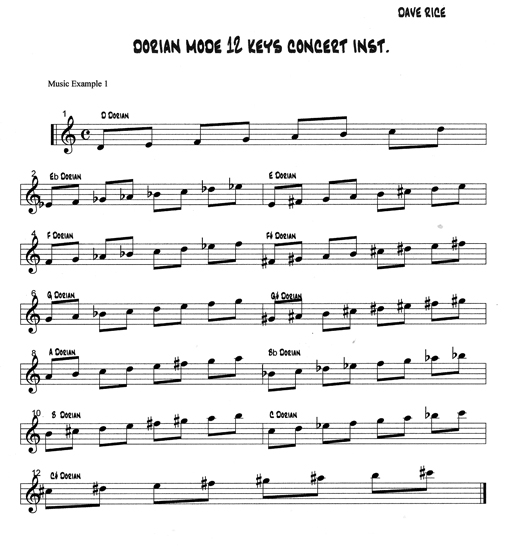
Next we will play the Dorian mode with the audio exercise on Bb instruments.
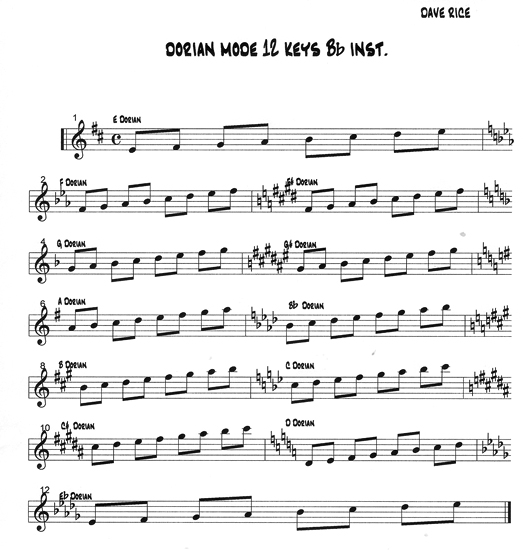
Next we will play the Dorian mode with the audio exercise on Eb instruments.
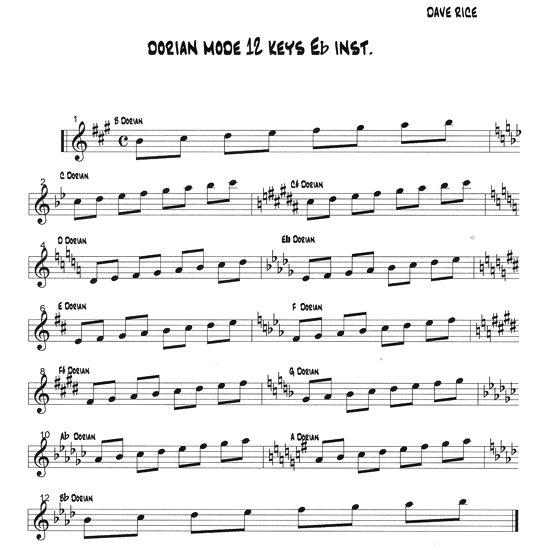
Lastly, we will play the Dorian mode with the audio exercise on F instruments.
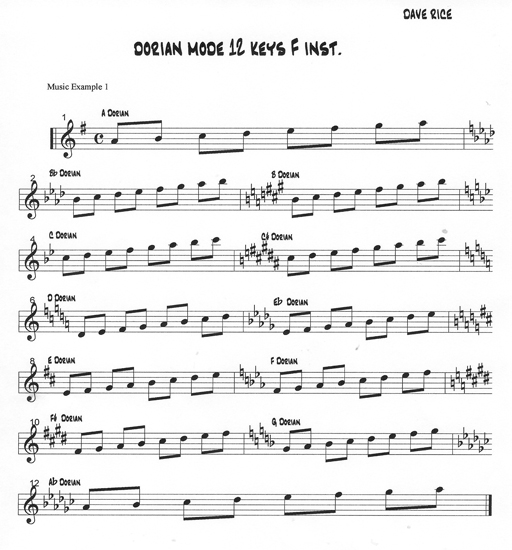
Modes are scales which are lines of notes in 2nds and/or 3rds ascending or descending. Modes are “inversions” of the Major scale. This means that all of the following modes are Diatonic to the C major scale .
D Dorian mode is the inversion of C Major (also called Ionian). D Dorian plays the notes of the C major scale except that instead of starting on C, it starts on D –thus aquiring its name D Dorian.E Phrygian mode plays from E to E encompassing the notes of the C major scale. F Lydian encompasses the notes of the C major scale from F to F. The G Mixolydian mode encompasses the diatonic tones of the C Major scale from G to G. The A Aeolian mode encompasses the diatonic tones of the C Major scale from A to A, and the B Locrian mode encompasses the diatonic tones of the C major scale from B to B (Mode, n.d.).
We
will now proceed to practice the remaining modes in this order: Ionian,
Phrygian. Lydian, Mixolydian, Aeolian, Locrian. The following music pages when
read will align with the practice tracks you will find on the “Jazz
Improvisation” page of the website www.davericeproductions.com or with the CD which is enclosed with
the packet. Please notice that following the concert keys there is a page for
you to practice if you play a Bb instrument and then a page if you play an Eb
instrument and finally an F instrument.

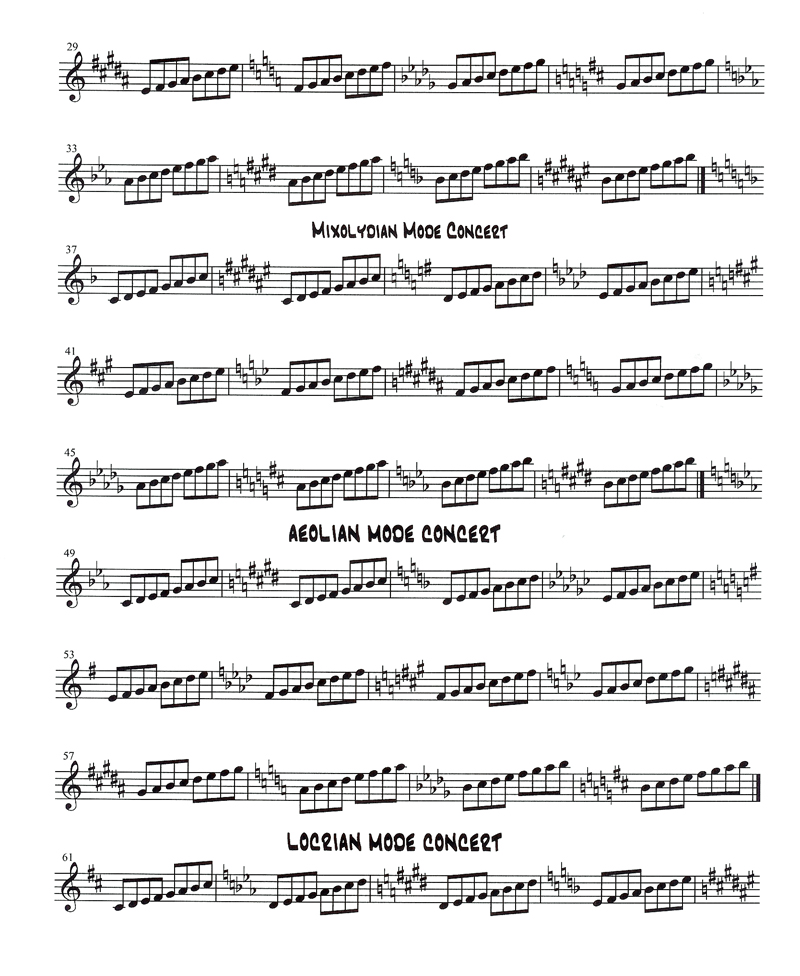
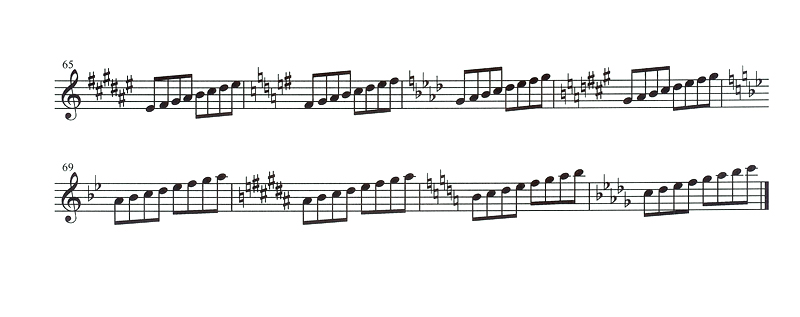
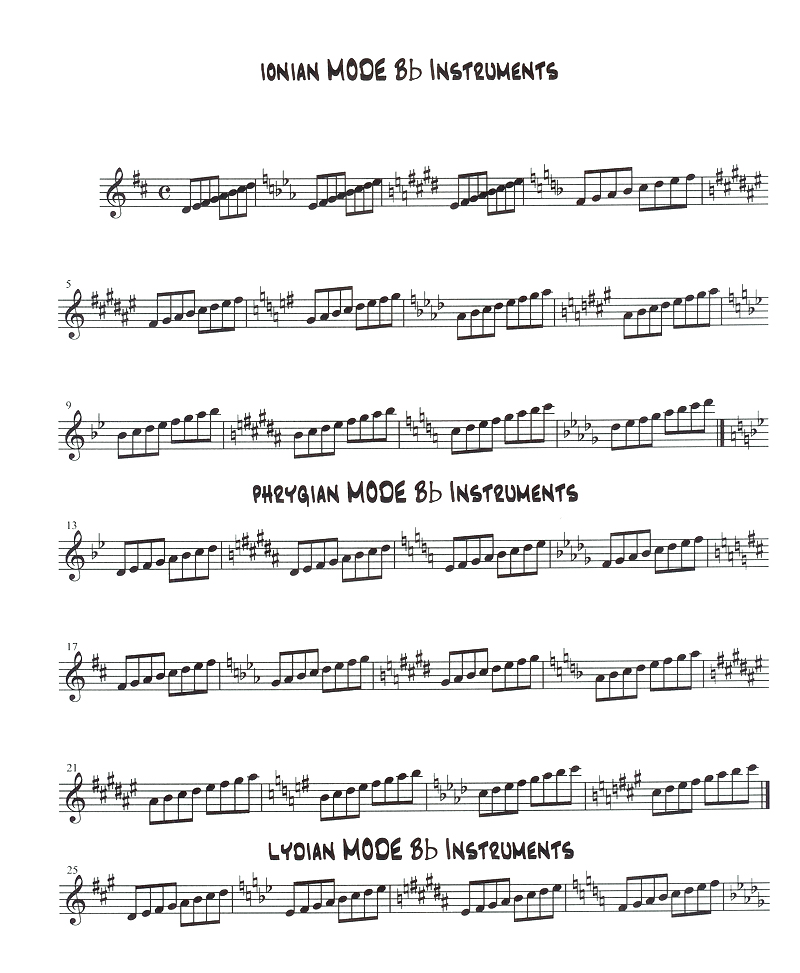
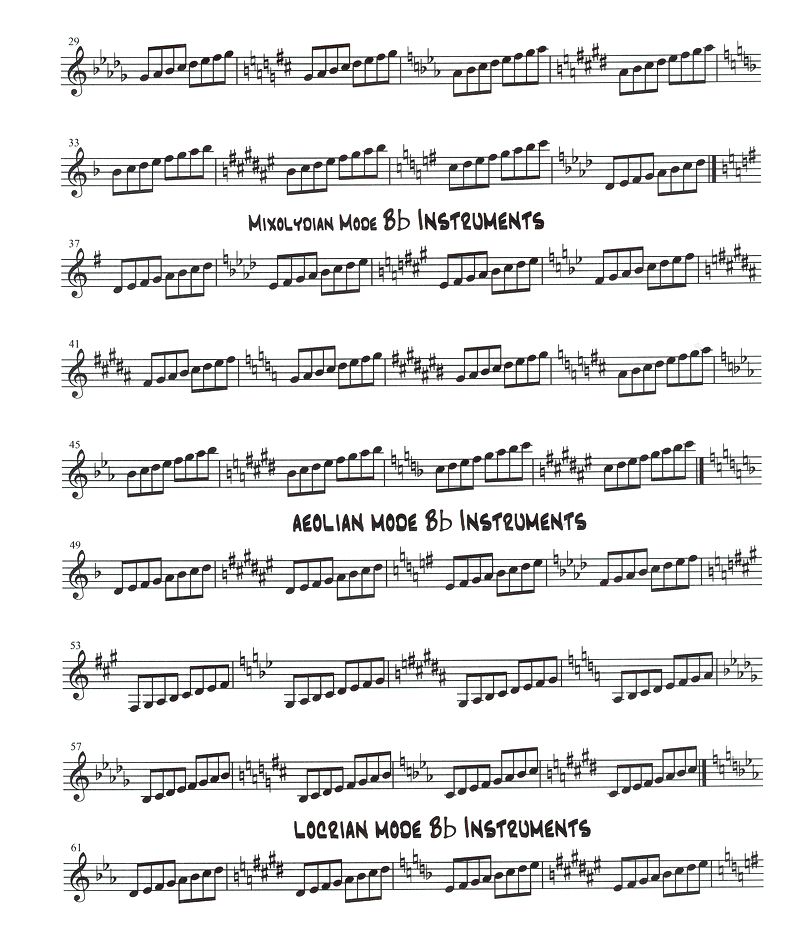
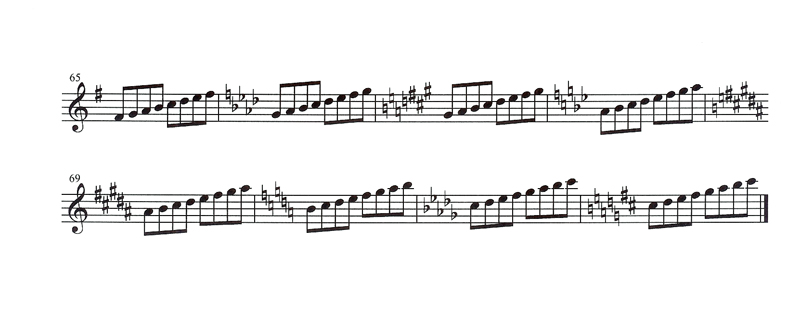
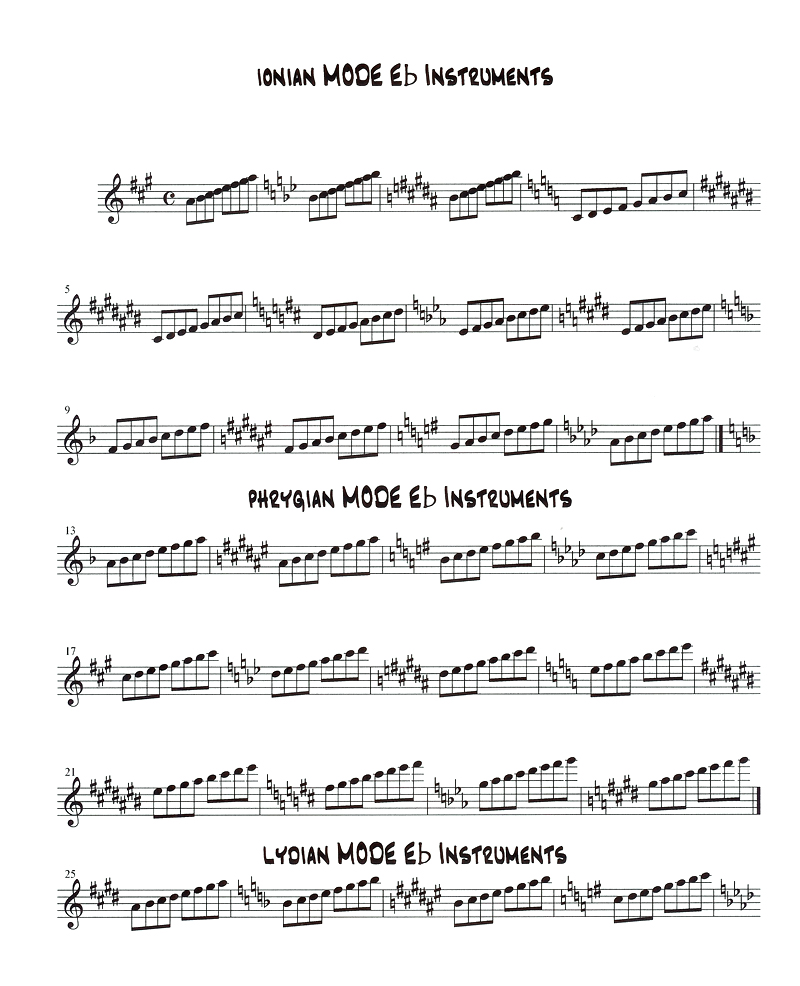
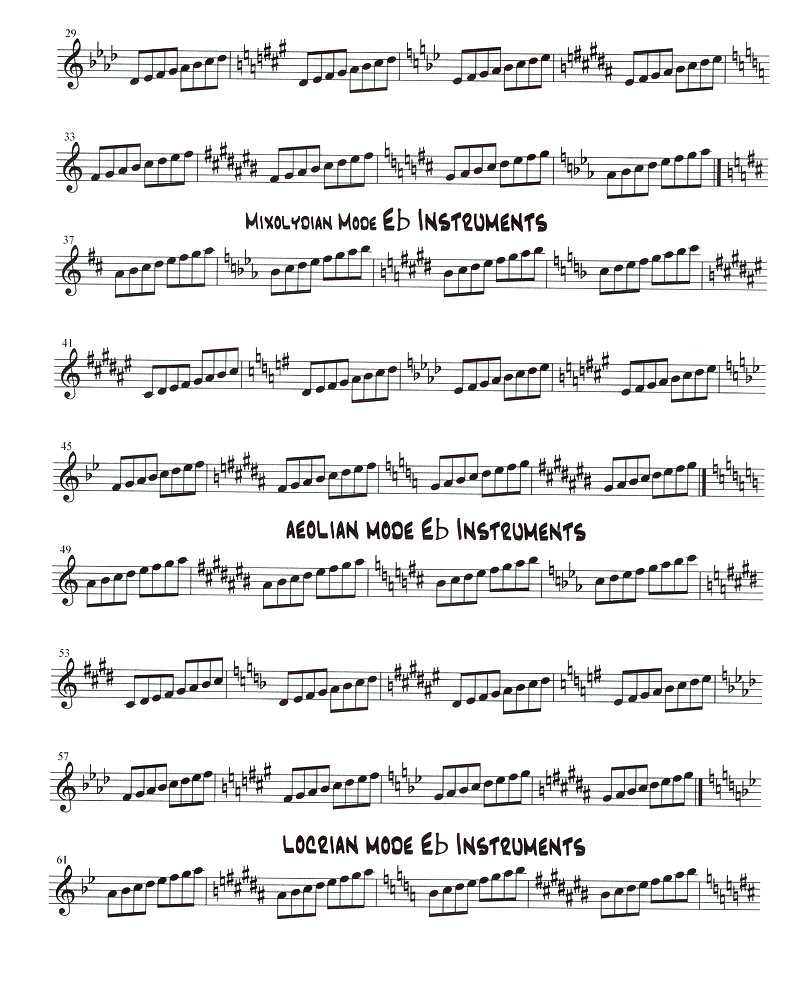
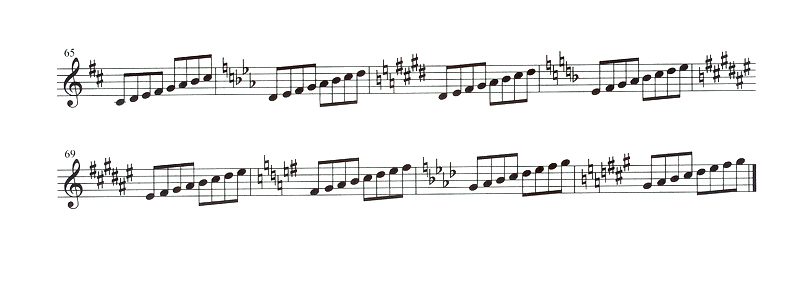
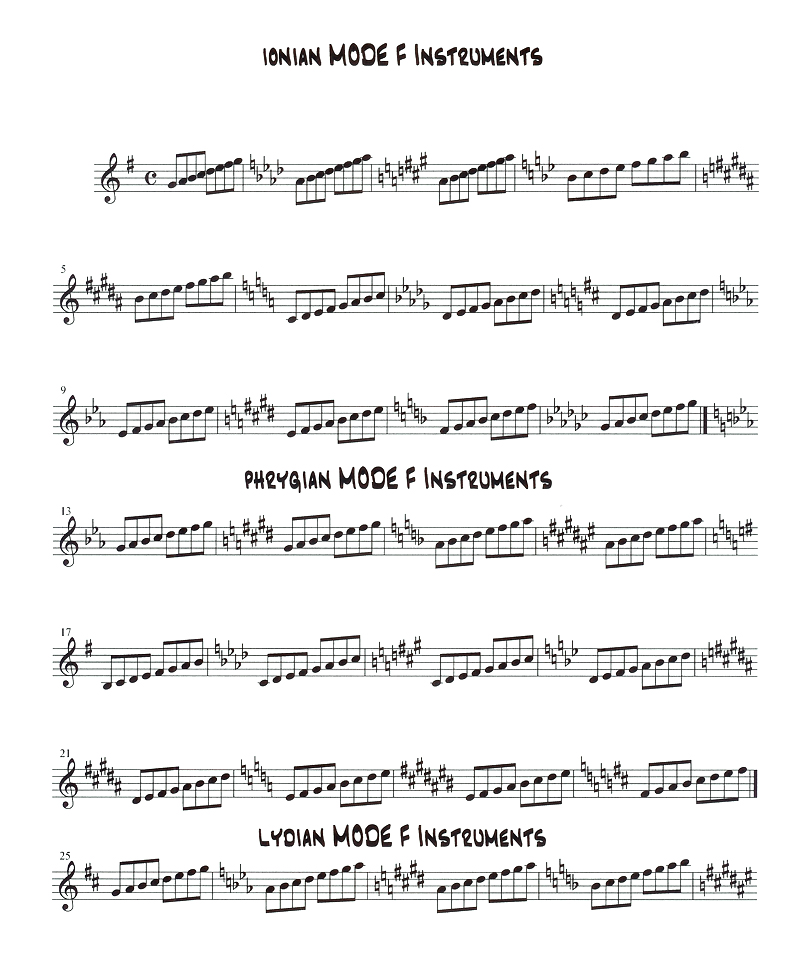
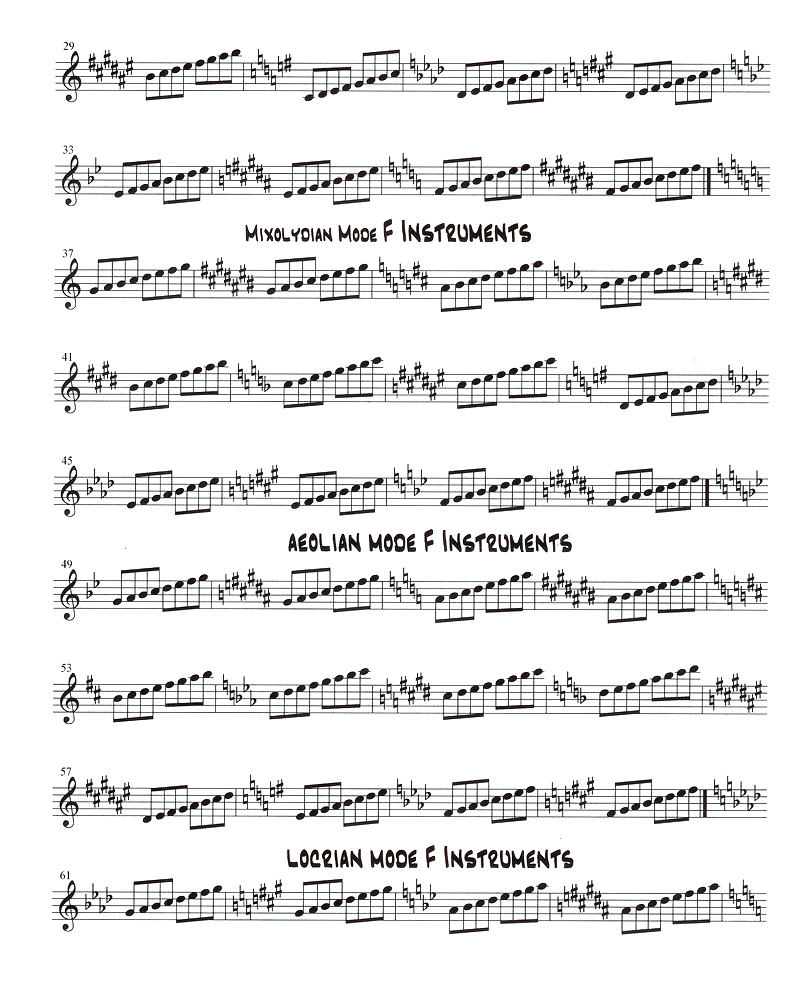
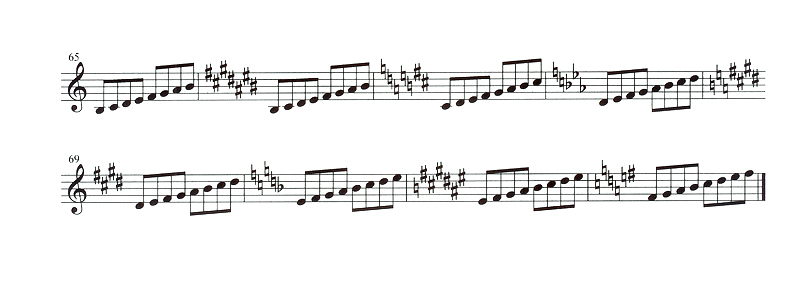
The musical modes are diatonic to the C major scale are related as follows.
C Ionian (C Major) C D E F G A B C
D Dorian D E F G A B C D
E Phrygian E F G A B C D E F
F Lydian F G A B C D E F
G Mixolydian G A B C D E F G
A Aeolian A B C D E F G A
B Locrian B C D E F G A B
Extremely
Important: Rule #2
Try playing each mode as a separate scale and try not to rely on your current knowledge of the major scale as a crutch. With the modes in front of you, think of them as separate scales unto themselves. The beginning student will rely on the major scale as a point of orientation.You must think of the Dorian mode on D as its own scale- a type of D minor scale. You must think of the E Phrygian mode as its own E minor scale. To do this practice the Dorian mode in all 12 keys on your instrument. As you are playing the scale, say the name out loud-ie-G Dorian, Bb Mixolydian, F# Locrian. This practice will help you to call on the modes as a source of tonal improvisation when the harmonic chord structure supports the use of that particular mode.
Exercise #2
First practice the Dorian mode in every key. The reason I have started with the Dorian mode and not Ionian is to peak the interest of the young musician who may feel a little overwhelmed or frustrated at this point. The first scales that I experimented with as a youth in 5th and 6th grade were the minor based Dorian and Aeolian modes. Next practice the Ionian mode in each of twelve keys. Then practice the Phrygian mode in each of twelve keys. Go through all the modes until you have completed all 7 modes. You now have 84 scales at your disposal for use in improvising. As I stated earlier, the modes as listed above line up with the audio tracks on the website or CDs enclosed.
Lesson
3 Chord Voicings
In this lesson we will understand how chords are constructed and how they are named. A chord is simply two or more notes played together at the same time. When a piano player strikes two or more notes on a piano or when a guitar player plays two or more notes on the guitar we have a chord.
The chord is named by intervals of 3rds. An interval is the distance between two notes. Recall that in lesson 1 we had a table of chords used in the diatonic major scale. We showed that there is an interval (or distance) between the root and the 3rd, and between the 3rd and the 5th tones of the scale. For demonstration purposes, in the key of C Major between C the root, and E we have an interval of a Major 3rd ( 4 ½ steps). Between E the third and G the fifth we have an interval of a minor 3rd. This creates a chord called a C major triad, the C root giving the chord its name.
There are four types of triads, which we will encounter. They are major, minor, diminished and augmented.
Major chord Root (name of chord) to 3rd - Major 3rd 4 half steps
3rd to 5th - minor 3rd 3 half steps
Minor chord Root (name of chord) to 3rd - minor 3rd 3 half steps
3rd to 5th - Major 3rd 4 half steps
Diminished Root (name of chord) to 3rd - minor 3rd 4 half steps
Chord 3rd to 5th - minor 3rd 4 half steps
Augmented Root (name of chord) to 3rd - Major 3rd 4 half steps
Chord 3rd to 5th - Major 3rd 4 half steps
Thus far we have looked at triads. We shall now go beyond the triad to the next interval above the fifth which is called the seventh. The seventh is seven scale tones above the root of the chord. There are 2 types of sevenths found in chords- the major seventh and the minor seventh. A major seventh is 11 half steps above the root, while the minor seventh is 10 half steps above the root.
When we refer to a seventh chord, the triad will already be understood by the name of the chord.
Dan Haerle writes in his book “Jazz/Rock voicings for the contemporary Keyboard Player”:
The 3rd and/or the 7th of the chord should normally be present in every voicing..In progressions of a 5th downward (4th upward), the following is always true:
A. The 3rd of a chord has the same letter name as the 7th of the next but may require a chromatic alteration.
B. The 7th of a chord should normally resolve downward stepwise to the 3rd of the next chord (Haerle,1974,p.iii).
Exercise #3a.
Play ii7-V7-I chord progressions in all 12 keys using a minor seventh chord for the ii, using a dominant seventh chord for the V7, and using a Major seventh chord for the I chord. This will familiarize you with using voicings between chord changes. Through experimentation you will find that you can leave out certain voices in the chord. Often a left hand can play just the root, 3rd, and 7th of the minor seventh chord, producing an open cleaner sound. Experiment and determine what sounds you like the best.
Play along with Exercise #1 first slowly, then build up speed using the chord voicings in this following chart. This chart appears only in concert because it pertains to polyphonic chordal concert instruments.
Lesson #4 Playing Scales over chord voicings
We are now at a major crossroad in our method and study of improvisation. Now is when we are really ready to begin improvising over chord voicings. This is really the crux of what playing jazz, blues, rock ‘n roll, country, Dixieland, funk, some pop, gospel, swing, and other styles is all about.
We
will start at a very easy level and work our way through to more advanced
methods. From this point forward you should establish a daily ritual of practicing ii-V7-I chord progressions in
all 12 keys incorporating the voicings and lines that you will learn from this
point forward. I really saw a profound difference in my own playing when I
began to practice these progressions on a daily basis in all 12 keys. Exercise 3b
We will begin with an elementary improvisation of the first 3 tones of the Dorian Mode over the ii chord, followed by the first 3 tones of the Mixolydian Mode over the V chord, followed by the first 3 tones of the Ionian Mode over the I chord. Practice this easy improvisation in use of scales over the Exercise # 1, which is ii-V-I Slow. D Dorian scale- D,E, and F played over the D minor 7th chord followed by G,A, and B over the G7 chord, followed by C,D, and E over the C major chord is the first progression. If you play piano voice the chords in the left hand and play the improvised melody in the right hand. Do not play bass notes in the left hand. If you play another instrument, play the notes we just cited over the recording provided with this series. The notes D, E and F are the simplest melody using the D Dorian mode G, A, and B the simplest using the Mixolydian Mode and C, D, and E are the simplest using the Ionian. Now play Ex.3b in Concert and the keys Bb, Eb, and F.
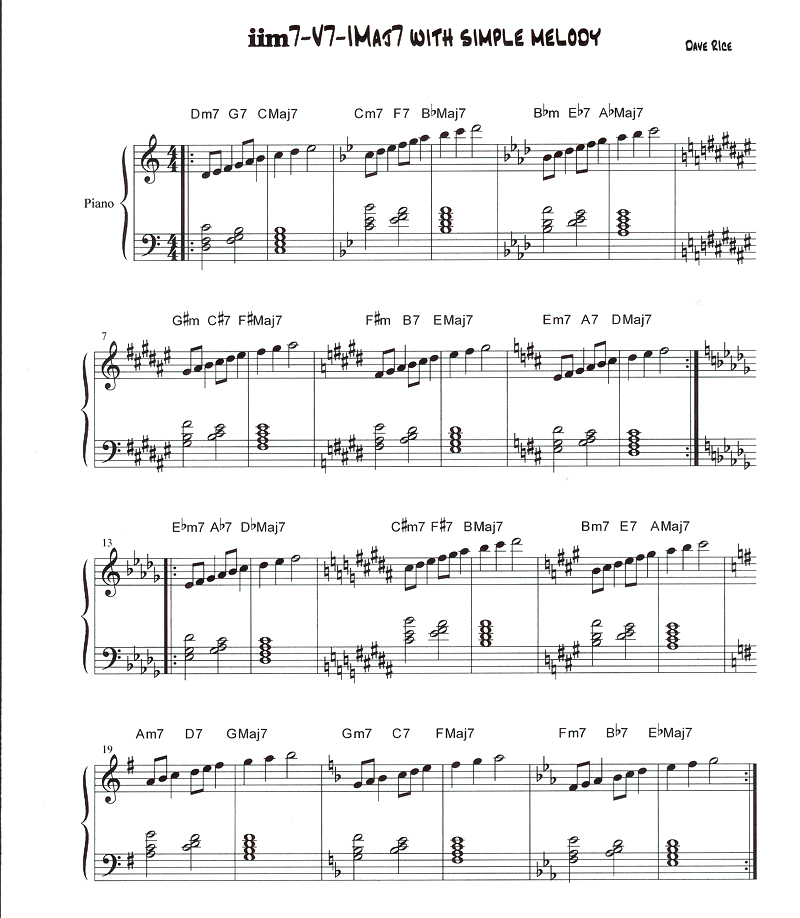
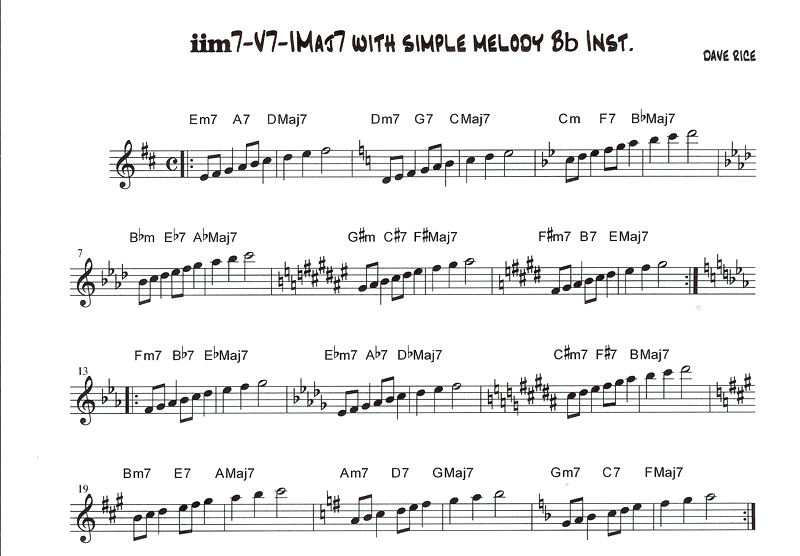
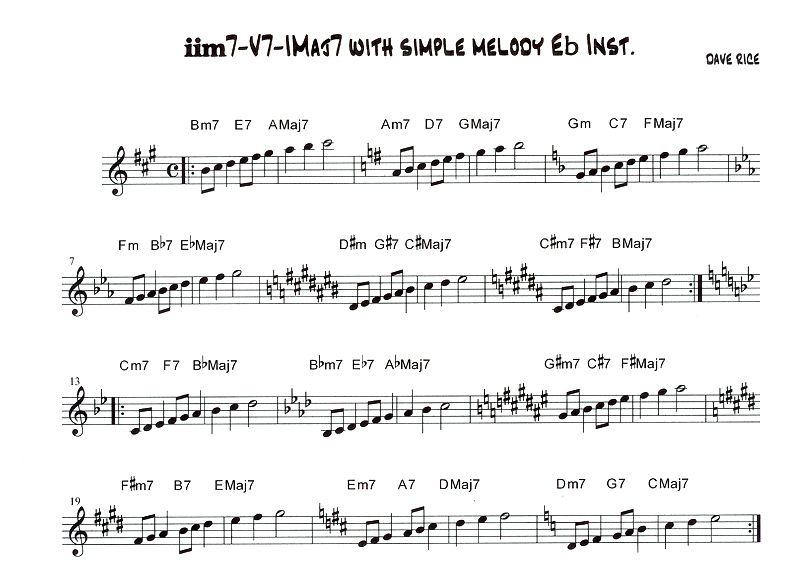
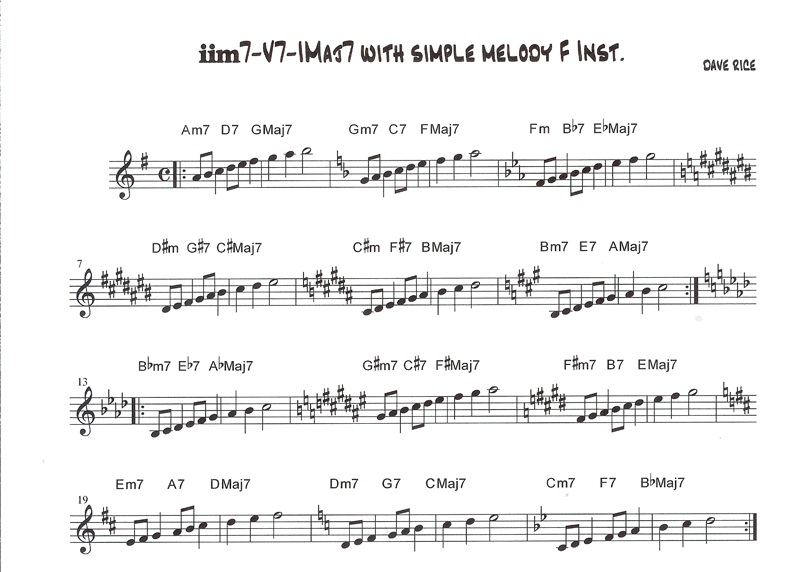
Exercise # 3 c
Now let's play the
full mode over the same slow chord progression, using the slowest
recording of ii-V-I . Use Exercise #3 slow. This will take you through all 12
keys so you must transpose the same melody line in other keys. The F7 is now the V7 chord Play F G A Bb C D EbF
over the F7 V chord. When you resolve the V7 to the I (Bb), play the Bb Ionian
or Major scale over the Bb. This downward transposition continues in whole
steps until you end on D major. Then begin the ii-V7-I progression in the key
of Db. In so doing you play Eb F Gb Ab Bb C Db Eb over the Eb ii7, Ab Bb C Db
Eb F Gb Ab as the Ab mixolydian over the Ab7 chord and Db Ionian over the Db
major which is the I chord. Each time you move downward one whole step you are
shifting the I chord down one step and thus your entire progression. This
forces you as a player to play and apply these scales in all twelve keys. It
will hone your harmonic skills and your ear training skills at the same time.
In the scope of jazz improvisation this is a very 'consonant' sounding
improvisation and you may think it sounds a little plain. Go ahead and practice
these modes because our next step will take us into much more interesting
tonality. At this time play the
following notes with Exercise #3 on the website or CD on the slowest speed. The
following concert music score is for guitar, vibes, piano, organ, etc.
Following it will be Bb instruments, Eb instruments, and F instruments.
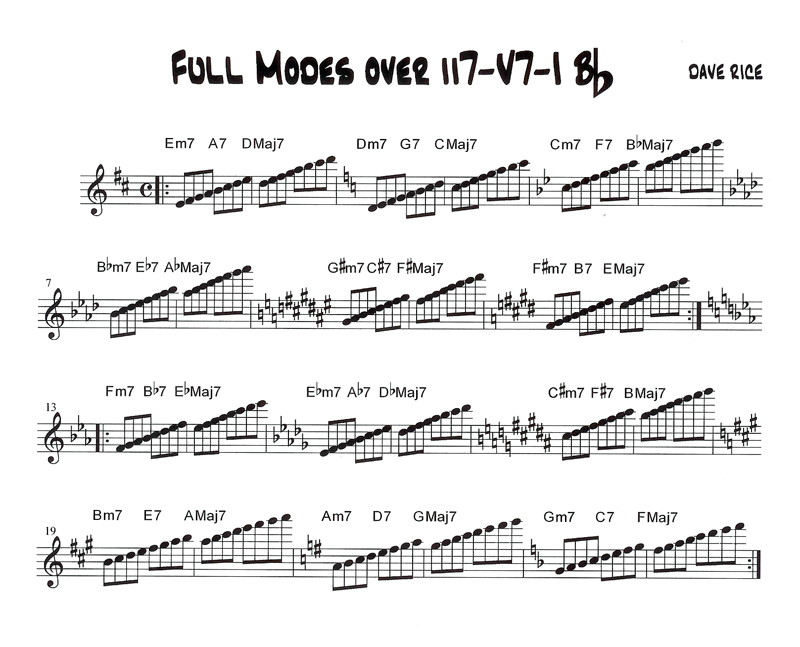

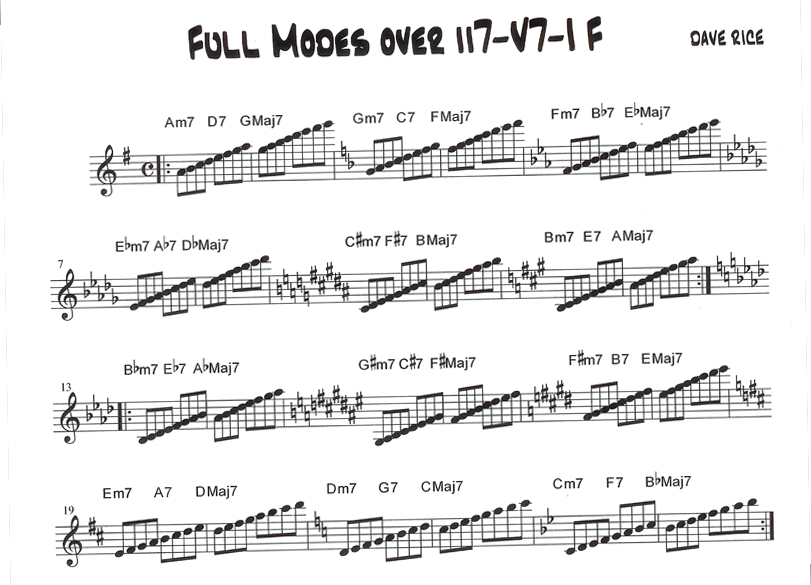
The Minor Chords and the Altered Scale
Hopefully, you have been practicing the minor ii- V7-I progression. This is a relatively simple progression with the modes used to play over the chords. Next, we will explore more complex chord changes and more possibilities of scales and voicings to use. In songs that are written in minor keys the triad over the first scale tone- the i chord is minor. (eg. In the key of C minor -C Eb G). Additionally, the ii chord has a third and a fifth that is flat. This results in a iiÝ7 chord called a half diminished 7 chord. This means that the triad is diminished and the seventh is a minor 7th above the root of the chord. D F Ab C spells the half diminished chord. If we follow our progression we will also find that the V chord is actually a V+7 which is the abbreviation for ĖG B D# F Ėa V augmented with a minor seventh. The triad itself is augmented and the seventh is a minor seventh. This chord has a strong sense of needing to resolve to a minor triad over the i chord, which is spelled C Eb G. Looking at the voicings of iiÝ7 to V+7 to I minor in all keys, we notice that the first six progressions of two measures each only include half the keys. Therefore, we must practice the entire progression one half step higher starting in the key of Db minor(C# minor). This progression winds around ending in the key of Eb minor. The Eb minor is the same as D# minor, so as you end the second chord progression exercise you switch from flats back into sharps.
As we are about to look at this progression there are three very important scales which fit wonderfully over the iiÝ7 to V+7 to I minor. These are the Diminished Scales, Half Diminished Scales and Altered Scales. Also important are the Minor Pentatonic and Blues Scales. The diminished scale is simply alternating whole and half steps. The diminished and half diminished scales are really inversions of one another. As you practice the scales you will discover that at every minor third the scale begins to repeat itself. You will also see that the half diminished scale is the same as a diminished scale simply starting on the second tone of the diminished scale. Many people consider the Half Diminished scale to be the same as the Locrian mode. The notes of the Locrian mode cover the tones of the minor 7 flat 5 chord. Those tones include the root, minor 3rd, flatted 5th and minor 7th. The Half Diminished Scale which is spelled C C# D# E F# G A Bb C also covers the same tones which are included in a Cm7b5. The sound is slightly different because this scale includes both the minor and major third in the chord. It also includes a major 6th above the root as opposed to a minor 6th which occurs in the Locrian mode. Your own preference will dictate which scale you use in improvisation. For the scope of this paper we will use the scale spelled with alternating half and whole steps as the Half Diminished. There are plenty of instructional materials available using the Locrian mode. Here are the Diminished, Half Diminished, Minor Pentatonic, Blues, and Altered Scales.
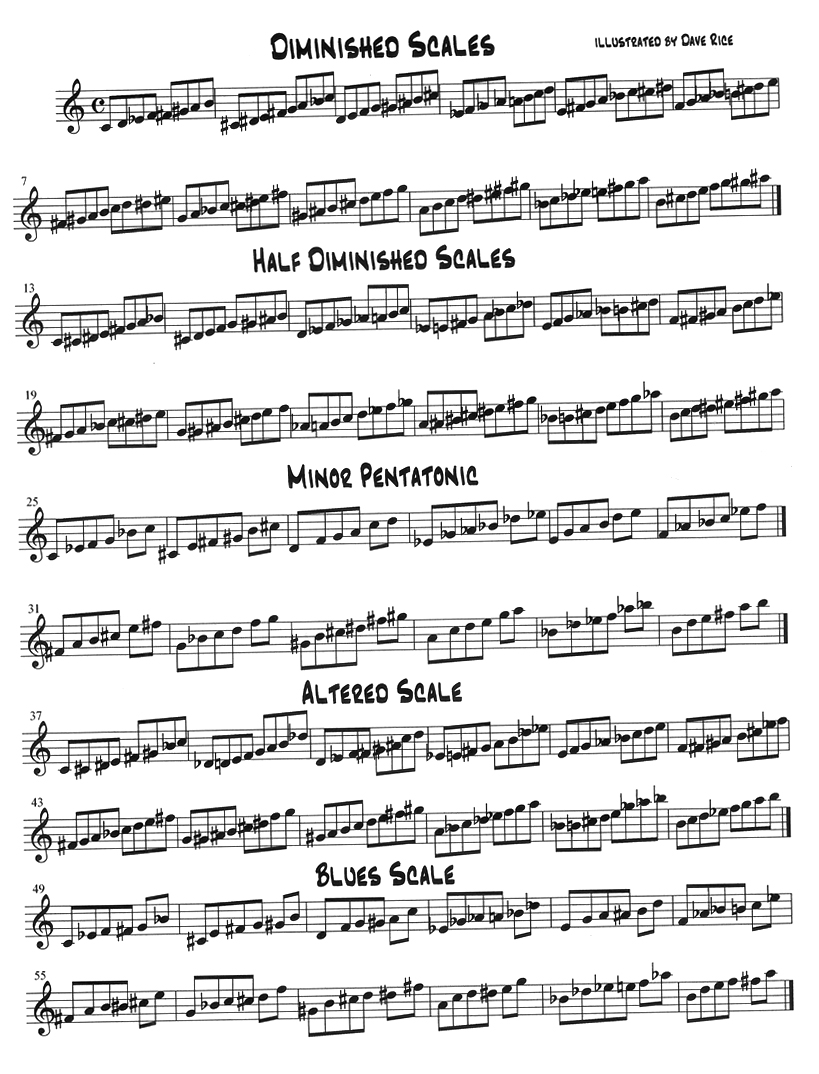
For example if we start on C and examine each diminished scale in chromatic half steps we see:
C D Eb F F#G#A B C
C# D# E F#G A Bb C C#
D E F G Ab Bb B C# D
Eb F F# G# A B C D Eb (Notice these are the same tones as first scale).
E F# G A Bb C C# D# E(Notice the same tones as the 2nd scale).
F G Ab Bb B C# D E F (Same as 3rd scale)
F# G# A B C D Eb F F#(Same as 4th scale)
G A Bb C C# D# E F# G(Same as 5th scale)
Ab Bb B C# D E F G Ab (Same as 6th scale)
A B C D Eb F F# G#A(Same as 7th scale)
BbC C# D# E F# G A Bb(Same as 8th scale)
B C# D E F G Ab Bb B(Same as 9th scale)
The next important scales to look at are the half diminished scales which are also alternating between half step andwhole step. These scales will also be symmetrical and repeat the notes every minor third as you practice them chromatically.
C C# D# E F#G A Bb C
C# D E F G Ab Bb B C#
D Eb F F# G# A B C D
Eb E F#G A Bb C Db Eb(Notice the same tones as the first scale).
F G Ab Bb B C# D E(Same as 2nd scale)
F F# G #A B C D Eb F (Same as 3rd scale)
F#G A Bb C Db Eb E F#(Same as 4th scale)
G Ab Bb B C# D E F G(Same as 5th scale)
G #A B C D Eb F F#G#(Same as 6th scale)
A Bb C Db Eb E F# G A(Same as 7th scale)
Bb B C# D E F G Ab Bb(Same as 8th scale)
B C D Eb F F# G# A B (Same as 9th scale)
Again, it must be emphasized that these scales are just alternating whole steps and half steps apart and that every minor 3rd they repeat each other. They are completely symmetrical. Also notice that the half diminished scale is just the same as the diminished scale starting one tone higher and therefore starting with a half step (or m2nd).
From this point forward for the rest of this presentation of ii-V7-I and ii-7 V+7 i, I would like you to practice these scales over the chord progressions of ii-V7-I and ii-7 V+7 i. If you play piano, organ, guitar, vibes, marimba or other polyphonic instruments practice chord voicings with scale lines over the chord voicings. If you play a linear instrument such as saxophone, trumpet, oboe, clarinet, etc. play the scales over the recorded ii-V7-I and ii-7 V+7-i exercises that come with this manual or that appear on the website www.davericeproductions.com . This gives you an opportunity to hear the interaction between the scales and the chord changes. We will suggest certain scales over chords but it is very important that you now begin to experiment with and choose different scales and modes to play over the ii-V7-I and ii-7 V+7-i progressions.
Here is one combination of scales to try. We will play the diminished scale over the ii-7 chord and the half diminished over the V+7 chord, then a Minor Pentatonic over the I chord. The Minor Pentatonic is just 5 notes starting on the tonic C Eb F G Bb. Over C minor. It is really simply constructed out of the Dorian mode using the root, 3rd, 4th,5th and 7th tones of the Dorian mode. At this time play the Diminished scale starting on the ii-7, Half Diminished scale starting on the V7+, and the Minor Pentatonic scale starting on the i minor chord.
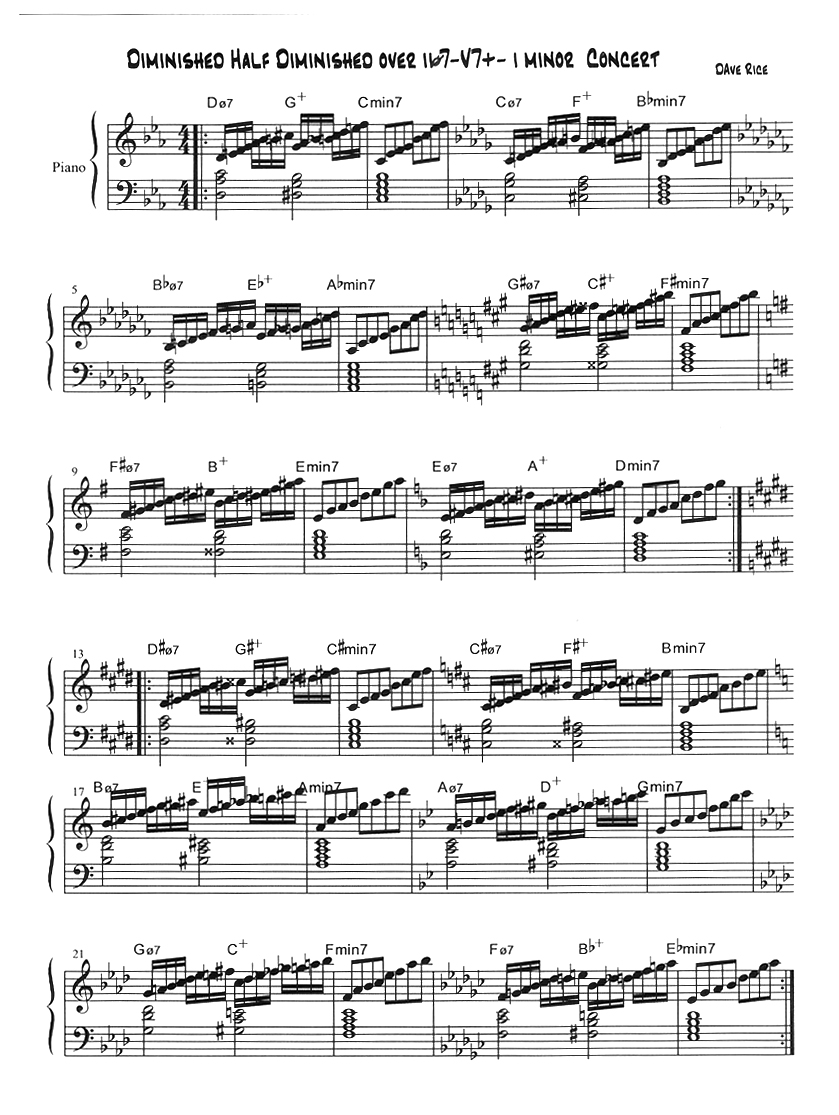
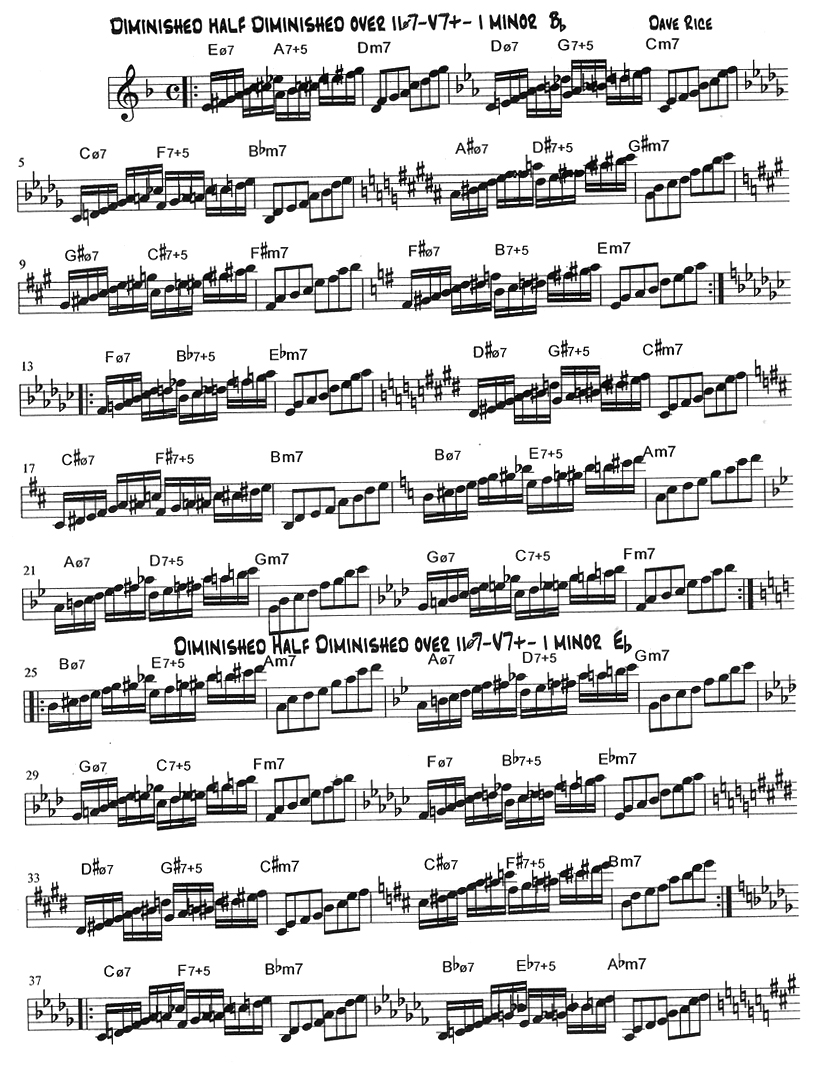
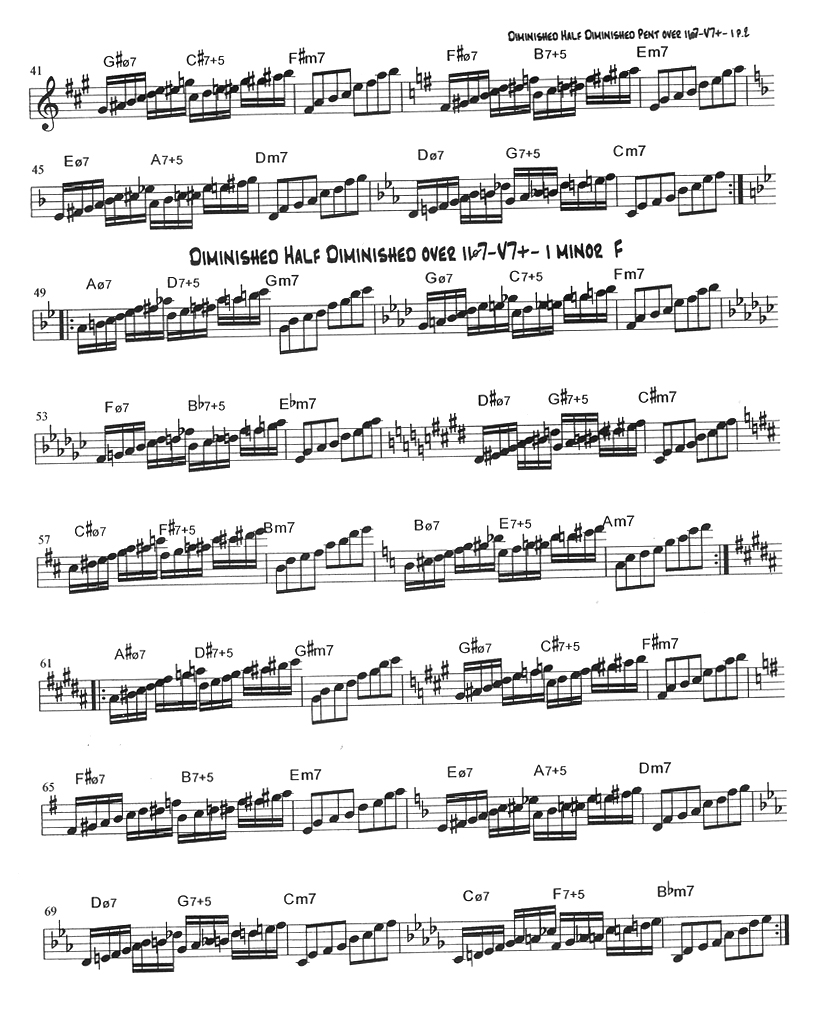
Now we will experiment with a scale called the altered scale. This is a scale which can be used over different chords but it is particularly useful over the V7 chord, or a chord which is being used as a dominant. The altered scale starts out like the half diminished scale Ė Ĺ step , whole step, Ĺ step up to the third and then it continues as a whole tone scale Ė ie- all whole steps up until you have reached the root again. So an altered scale played over a G7 chord would be spelled G,Ab,Bb,Cb(B),Db,Eb,F,G. Let's play an exercise over the ii-7 chord , V+7, and i minor. We will use the half diminished scale over the ii-7, an altered scale over the V7+ and a blues scale over the I minor.
Try this combination over the slowest ii-7-V7+-I minor audio exercise or you can play the same scales over the ii7-V7-I exercise.
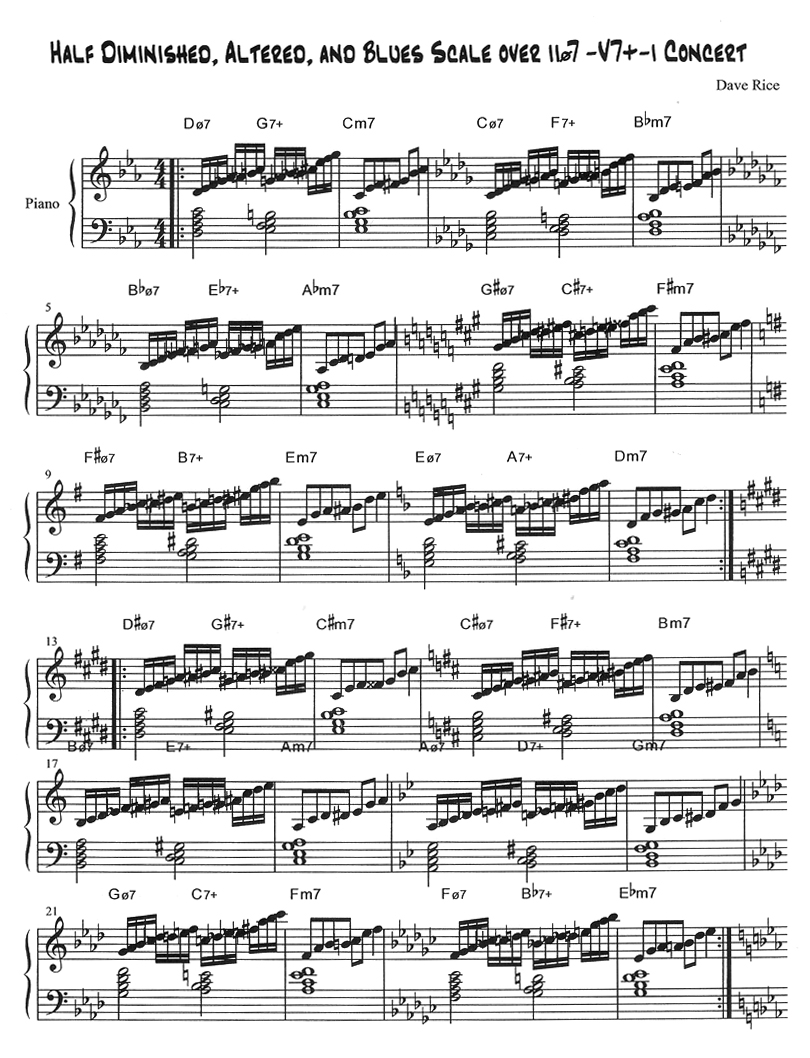
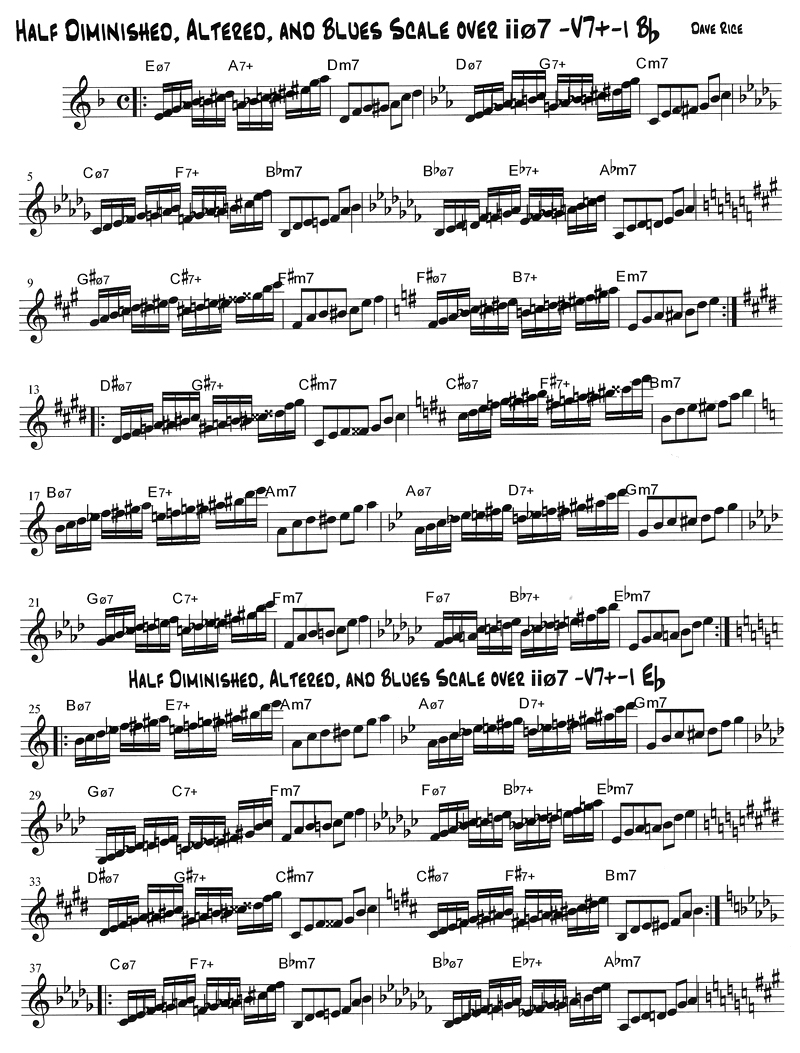
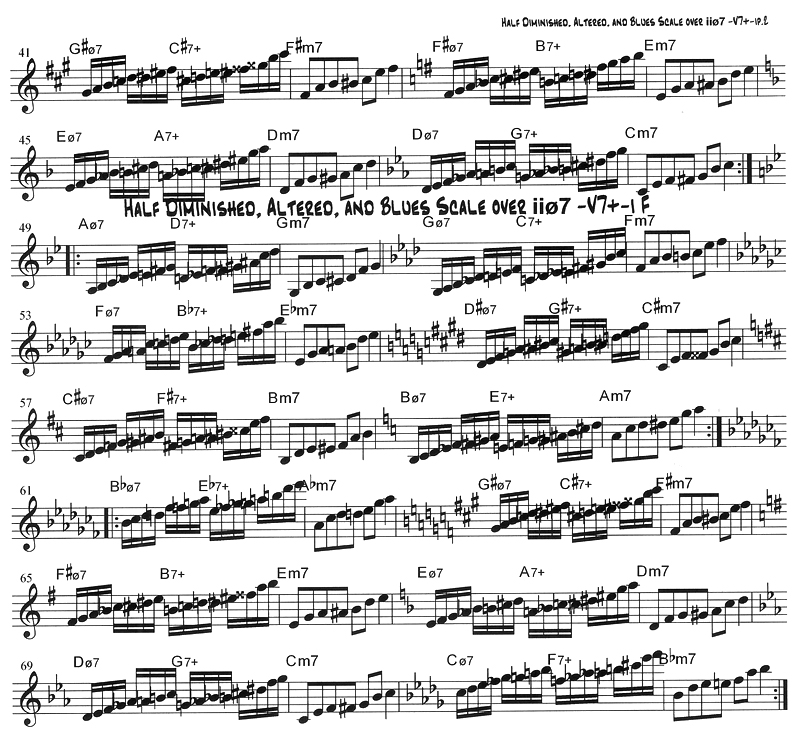
Bitonality
Bitonality refers to two different tonal centers- thus the prefix ďbiĒ. We mostly use the bitonal harmonies on V7 chords although you will find it on other chords. As you play jazz and read charts you will see complex chords that have names like. C9 #11, D+5+9, F# b5b9, A+9#11. All of these chord symbols refer to raising and lowering the upper harmonies of the chord structure. Once you have established the 3rd, 5th, and 7th of the chord, the upper harmonies are listed separately in the symbol. As a matter of protocol if the 3rd is not indicated it is understood to be a major 3rd above the root.
Also if an interval which is indicated in the chord is higher than the 7th, for example +9, b9,#11, b11, and the chord is a dominant 7th chord, then the 7th is understood to be a minor 7th above the root. To make this much more interesting and perhaps easier think of chords in jazz as having two parts, the upper and lower tone center. The lower tone center is the root, sometimes a third, sometimes a fifth and usually including the 7th. The upper harmony will include usually a 9th, sometimes an 11th, sometimes a 13th, and often the 5th which may have been omitted in the lower harmony. All of this will be indicated on music in a moment. When we view the chords as a lower and upper harmony we see that we can have a lower triadic harmony with the seventh and a completely different triad on top. This is very important because we can play the upper triad which is 'stacked' on top of the lower harmony, and we can solo on top of the upper harmony. This practice was widely used in the soloing of Charlie Parker and especially in the playing of artists such as Herbie Hancock and Michael Brecker. Before we list the upper triads to look for make sure that you practice the Diminished, Half Diminished, and Altered scales over the ii7-V7-I progressions and ii-7-V7+-i progressions in all twelve keys because these three scales will encompass all of the bitonal stacked harmonies we are about to talk about.
We will use the C chord as an example. You should realize that all chords can have the same stacked bitonal harmonies. Play C the root and Bb the 7th as the lower harmony in your left hand. Above this chord one may stack any of the chords in the whole tone scale above the root C. So, we may play a C triad over a C7. A D triad played over a C7 results in a #11, 13 chord. An E triad played over a C7 chord results in a Major 7 +5. A F# triad played over a C7 creates a C7 b5b9. A G# triad over a C7 results in a C7+5+9. A Bb triad over a C7 is called an 11 chord. Please note that often times when an 11th chord is played, the third is omitted because the 11th will clash with it. Also, other triads not found in the whole tone scale may be superimposed above a C7 chord. An A triad played over a C7 results in a C b9 13 chord. An Eb triad played over a C7 results in an +9 chord. Sometimes a composer will write the chord as G#/C or Eb/C.The writer finds that it is easier to simply list the two separate tonal centers. This now gives us a fresh approach to improvisation. Now when improvising over a chord, use all of the various scales practiced over the upper and lower harmonies which are suggested in the chord. When we combine all of the scales we have studied thus far and play them over either the upper or lower harmonies of the chordal structure we have hundreds of ideas to choose from in improvising over a jazz progression.
Below is a list of the chordal possibilities over just the C chord. It is up to you as a good studious musician to practice these in all the twelve keys. You have the ii7-V7-I and iiÝ7-V7+-i progressions to practice with. Start on the slowest speed and build your tempo up as you increase your skill in all twelve keys.
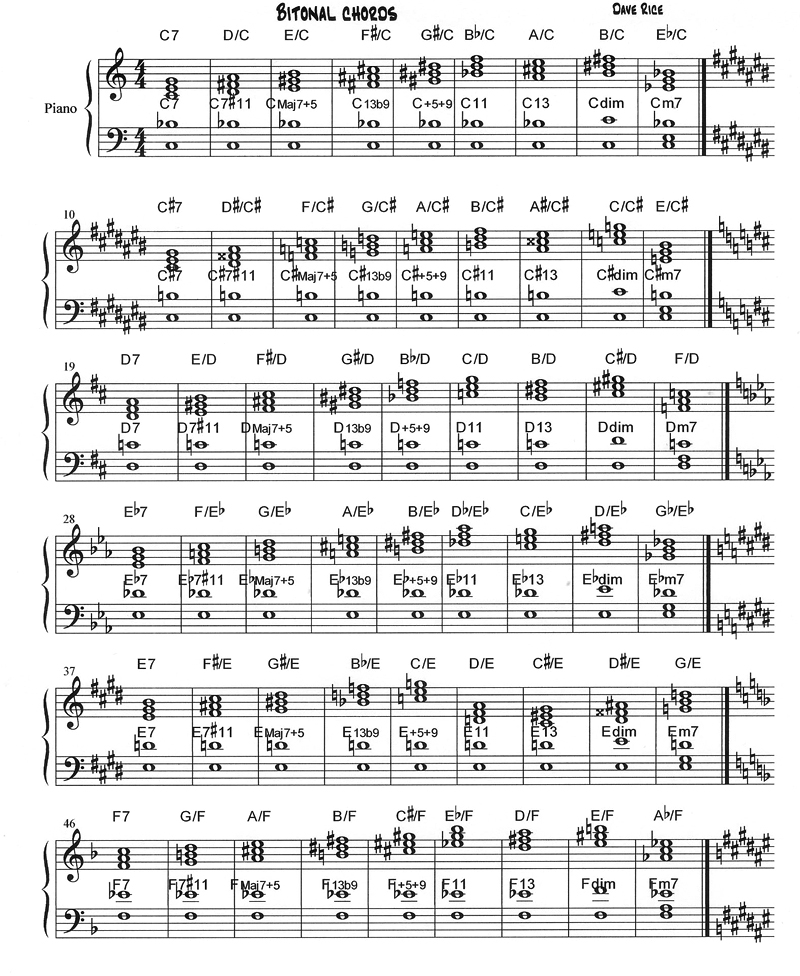
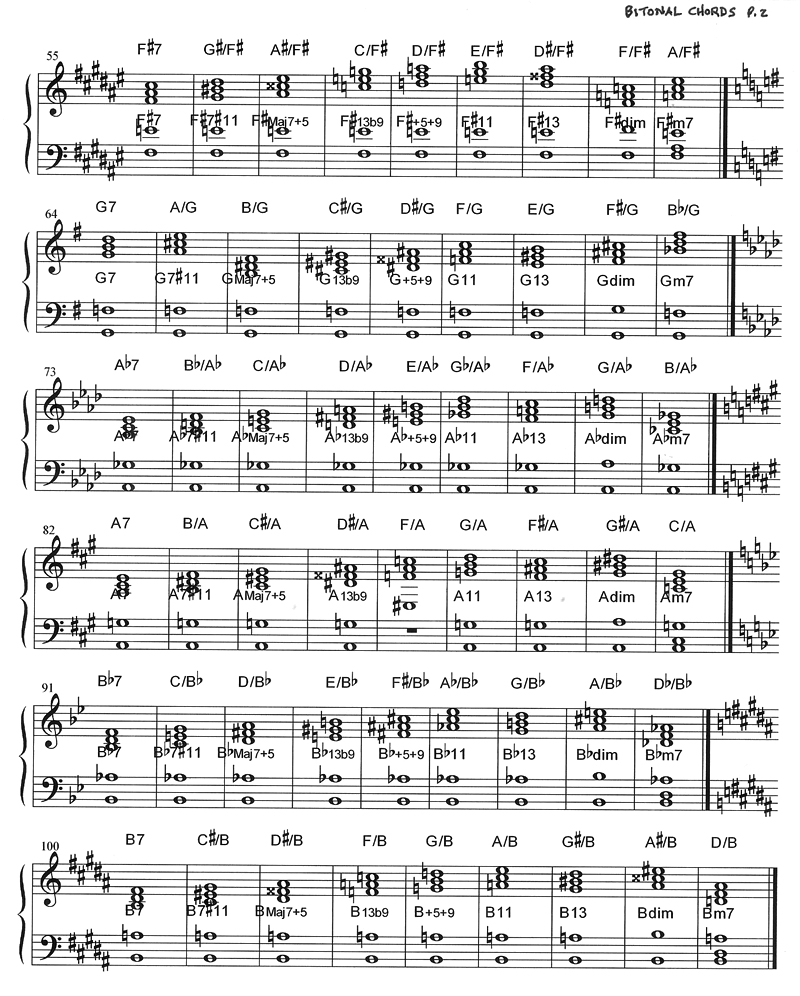
Blues
The next area that we will cover briefly in this text is the chord progression called the Blues Progression. This progression is tied into jazz so closely that the two cannot really be separated, and any study of jazz would be remiss in not having a section on the blues.
There are many deviations of the blues progression and anyone who listens to deep southern country blues will hear uneven numbers of measures and odd progressions, but in general there are two progressions which are most common. They are the I IV V7 progression which is a more common shuffle or rock progression, and the I IV V7 with a iii-VI ii V7 Ė I turnaround which we hear frequently in bebop. Earlier we listed the blues scale in the same illustration in which we saw the altered scale and diminished scale. The unique thing about the blues scale is that the minor third is used over a major chord creating the dissonant clash of minor against major, and that the fourth is used with the sharp or raised fourth into the fifth. With instruments like the saxophone or guitar the fourth and raised fourth can be bent upward into the fifth.
When you play a blues you can play a straight progression like this one, which is a typical Country or West Side Chicago Blues progression:This progression is used frequently in RockíníRoll Blues songs. Here is a 12 bar blues in each key.
|| C7 | F7 | C7 |C7 | F7 | F7 | C7 | C7 | G7 | F7 | C7 C/E F7 F#dim.| C7 G7 ||
||C#7 | F#7 | C#7 |C#7 | F#7 | F#7 | C#7 | C#7 | G#7 | F#7 | C#7 C#/E# F#7 Gdim.|C#7 G#7 |
||D7 |G7 | D7 |D7 |G7 | G7 | D7 |D7 | A7 | G7 | D7 D/F# G7 G#dim.| D7 A7 ||
||Eb7 | Ab7 | Eb7 |Eb7 | Ab7 | Ab7 |Eb7 | Eb7 | Bb7 | Ab7 | Eb Eb/G Ab A dim| Eb7 Bb7||
||E7 | A7 | E7 |E7 | A7 | A7 | E7 | E7 | B7 | A7 | E7 E/G# A A#| E7 B7 ||
||F7 | Bb7 | F7 |F7 | Bb7 | Bb7 | F7 | F7 | C7 | Bb7 | F7 F/A Bb7 Bdim.| F7 C7 ||
||F#7 | B7 | F#7 |F#7 | B7 | B7 | F#7 | F#7 | C#7 | B7 | F#7 F#/A B7 Cdim.| F#7 C#7 ||
||G7 | C7 | G7 |G7 | C7 | C7 | G7 | G7 | D7 | C7 | G7 G/B C7 C#dim.| G7 D7 ||
||Ab7 | Db7 |Ab7 |Ab7 |Db7 | Db7 | Ab7 | Ab7 | Eb7 |Db7 | Ab7 Ab/C Db7 Ddim.|Ab7 Eb7||
||A7 | D7 | A7 |A7 | D7 | D7 | A7 | A7 | E7 | D7 | A7 A/C# D7 D#dim.| A7 E7 ||
||Bb7 |Eb7 |Bb7 Bb7 | Eb7 | Eb7 | Bb7 | Bb7 | F7 | Eb7 | Bb7 Bb/D Eb7 Edim.|Bb7 F7 ||
||B7 | E7 | B7 |B7 | E7 | E7 | B7 | B7 | F#7 | E7 | B7 B/D# E7 Fdim.| B7 F#7 ||
The peculiar thing about a blues scale is that in a simple blues progression like the one above the blues scale, which is built on the tonic (first tone) of the I chord, can be played over all of the chord changes and it will fit. You can hear many traditional blues recordings of artists like Muddy Waters, Howlin' Wolf, Chuck Berry, Little Walter, and many more playing this single scale over an entire progression. You can practice this progression with the Medium Shuffle on the website www.davericeproductions.com or the CD packet which comes with this text. The medium speed is the closest version to the old style blues shuffle.
Now let's look at the blues which is used more in jazz and bebop. I once asked Herbie Hancock to tell me one thing to improve my jazz playing. He thought for a minute and replied,"I know alot about substitution chords". The following progression begins with the same shift from the I chord to the IV and to the V7 but in between the main chord changes you will find passing chords such as iii7, VI7, ii7-V7 as well as substitution chords which are passing chords that sound the interval of a tritone away from the original chord. When you practice the slow and fast versions of the blues progression with the audio exercises which are included, each time you move to the next significant chord in the progression which is a perfect fourth away-ie-I7 IV7, or V7 , first play a dominant 7th chord or 13th chord which has a root which is a raised 4th away and descend down to the destination chord. For example, when moving from C7 to an F7 , play the C7 and then play the F#7 or F#13th chord before moving to the F7. The F#13 is a substitution for the C7. This practice is used all the time in playing blues and taken to the extreme in bebop. The first time I learned about tritone substitution chords I was playing in St. Louis at a convention center where I met the keyboard player from the band the ďFifth DimensionĒ. He sat down and showed me the substitution chords for jazz blues and ii7-V7-I. He also showed me how to approach each chord with a ii7-V7 as a substitution. I remember immediately hearing all the great harmonies that I had heard in jazz recordings. We will examine a bebop blues progression in which we will use many substitution chords throughout the progression. As you practice this progression with the substitution chords, each time you play a seventh chord play the minor chord which is a fourth away from the seventh chord. This makes the substitution chords and the progressions all ii7-V7 progressions
which opens up all the possibilities of soloing on top of the ii7-V7 and I in whatever function it may assume. So we can consider the iii-VI7 as a ii7-V7 of the ii and use the same modal, diminished, half diminished, altered scales and endless possibilities that are available to us. Play the following progressions along with the audio exercises on the website www.davericeproductions.com or with the CDís that come with this text.
We will now practice the final audio exercises with the fast blues progression and use the substitution chords throughout. The following exercises are blues progressions played one time in the starting key and then modulated down one whole step. This will take the reader through the blues in C,Bb,Ab,F#,E, and D. The progression is then repeated in Db,B,A,G,F, and Eb. You will have the opportunity to practice blues in all keys in a slow style, in a medium shuffle, and finally in a jazz bebop style.
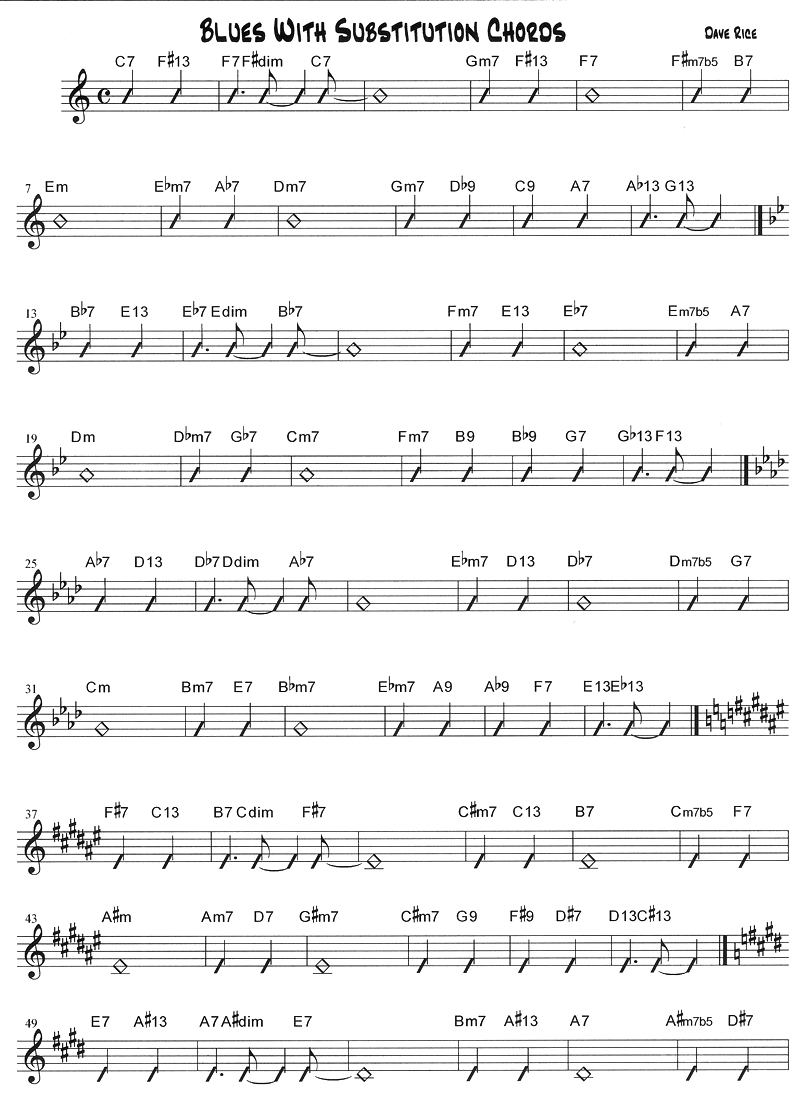
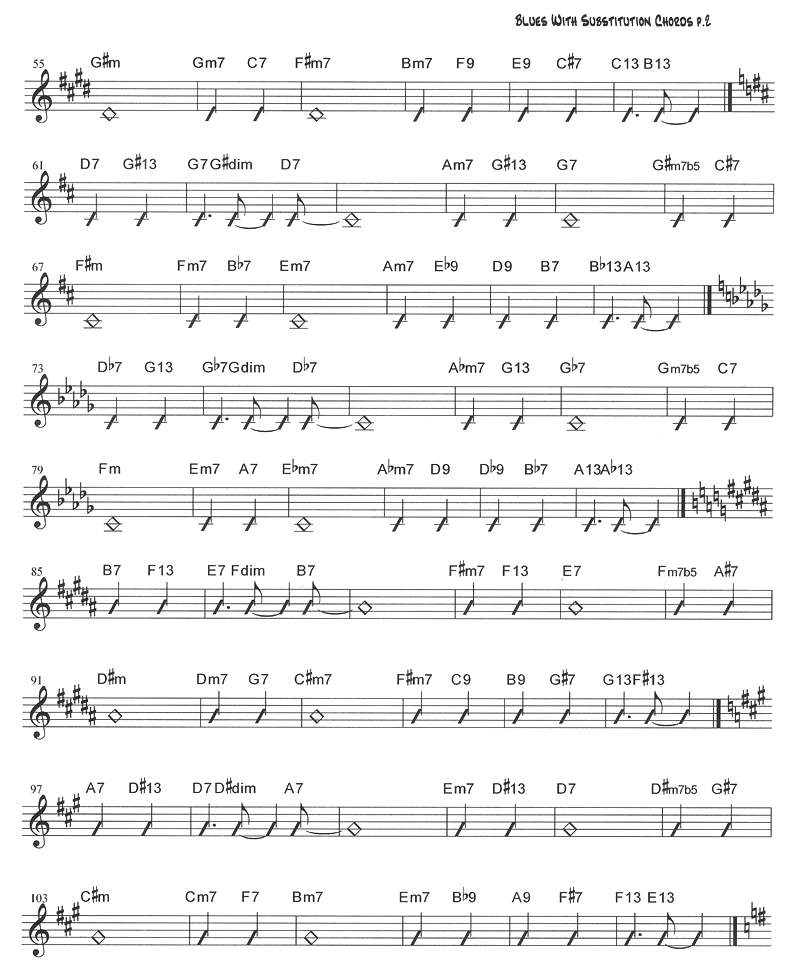
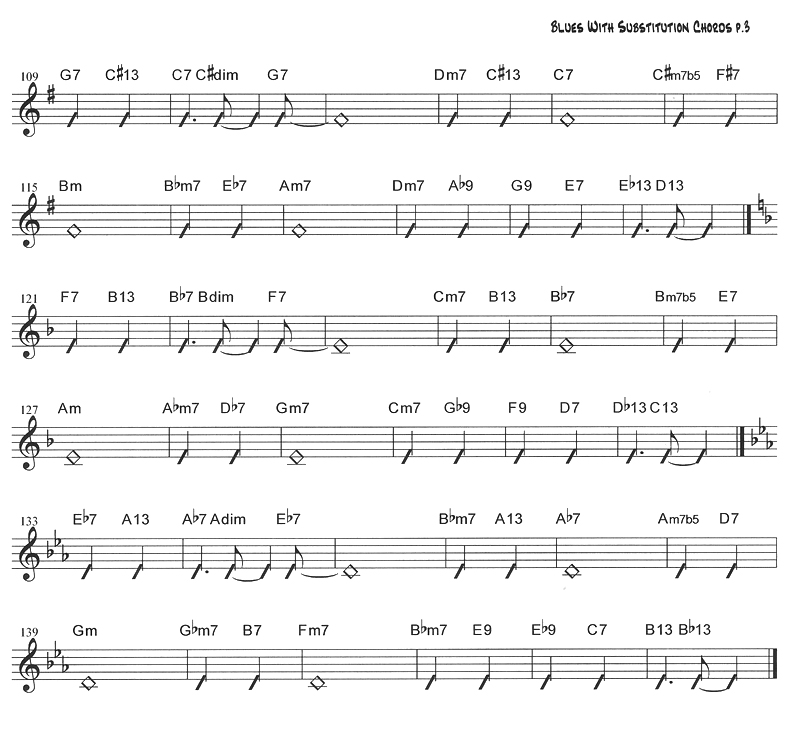
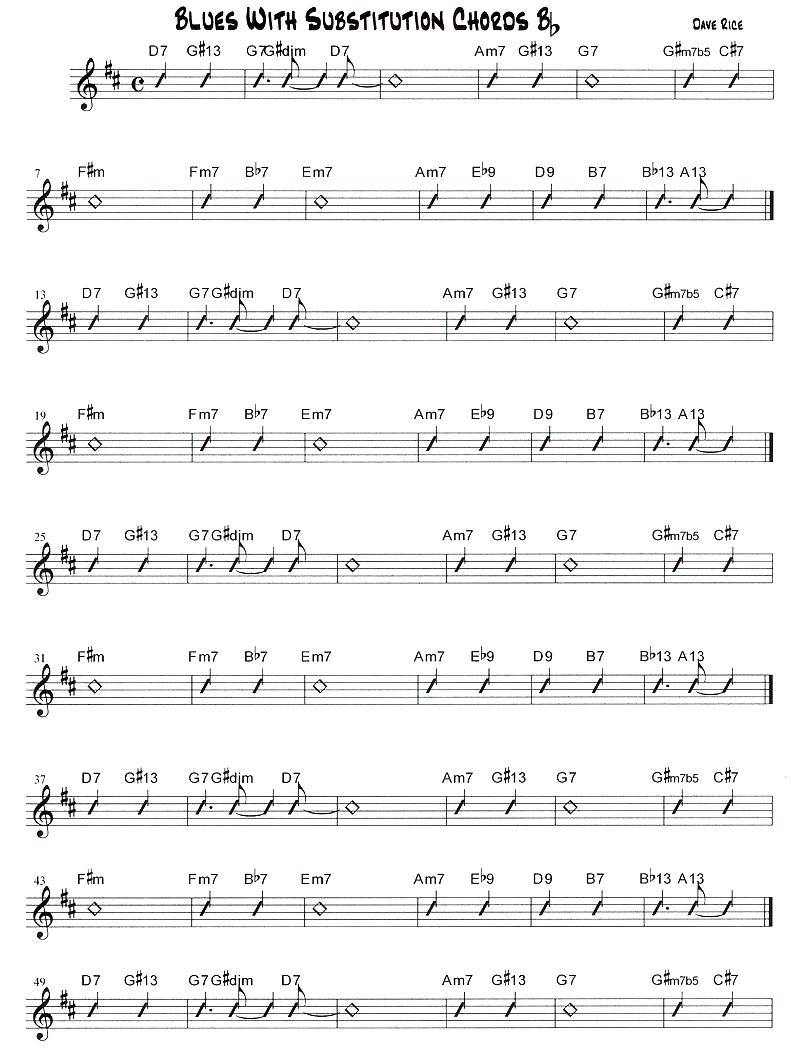
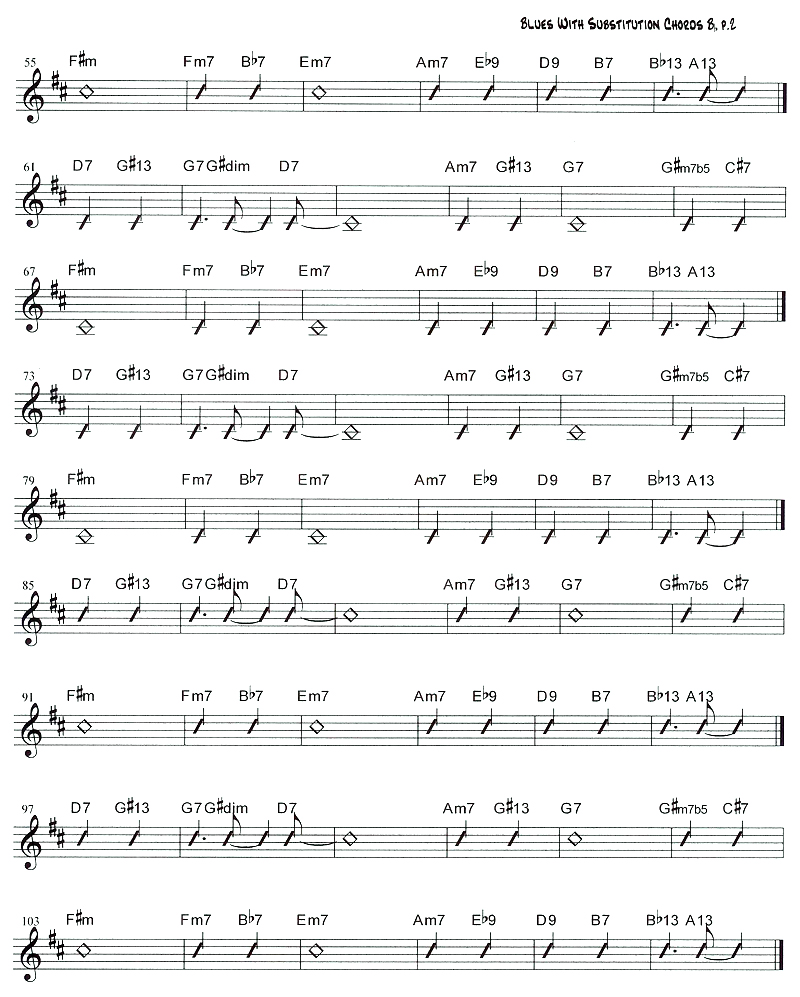
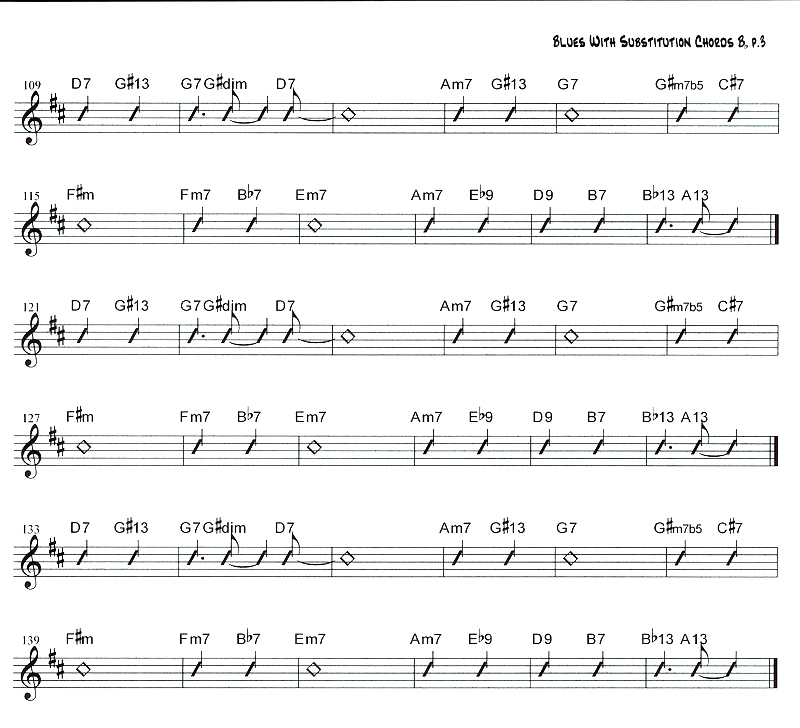
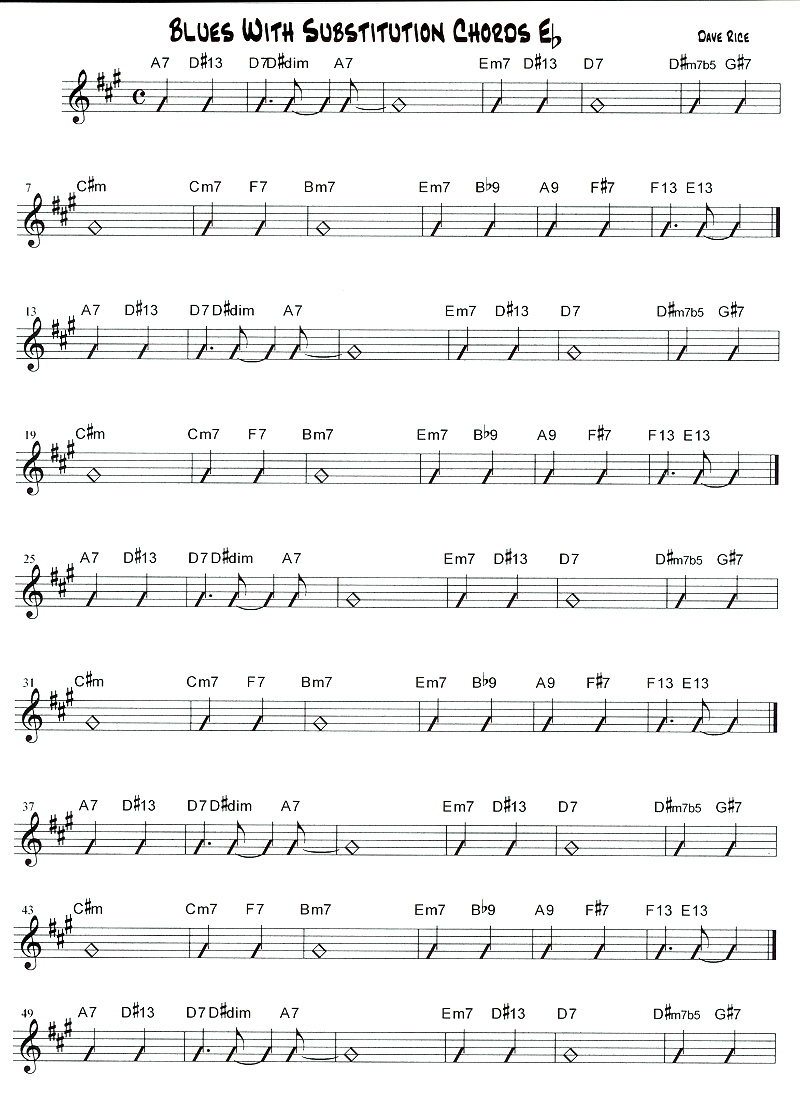
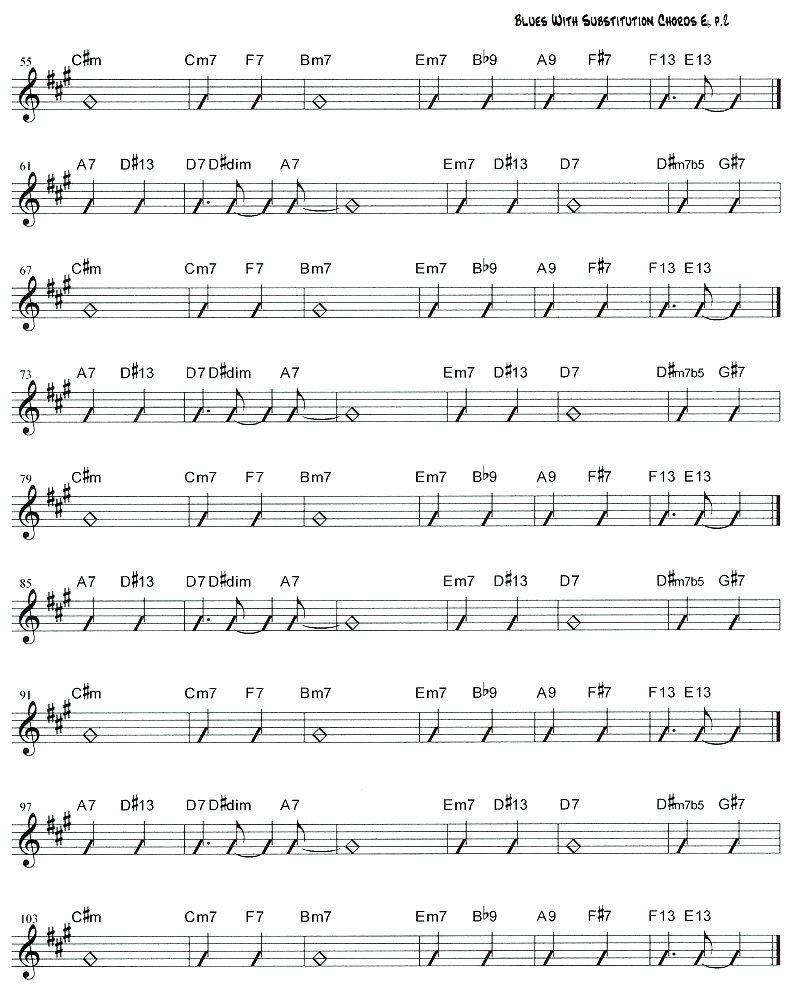
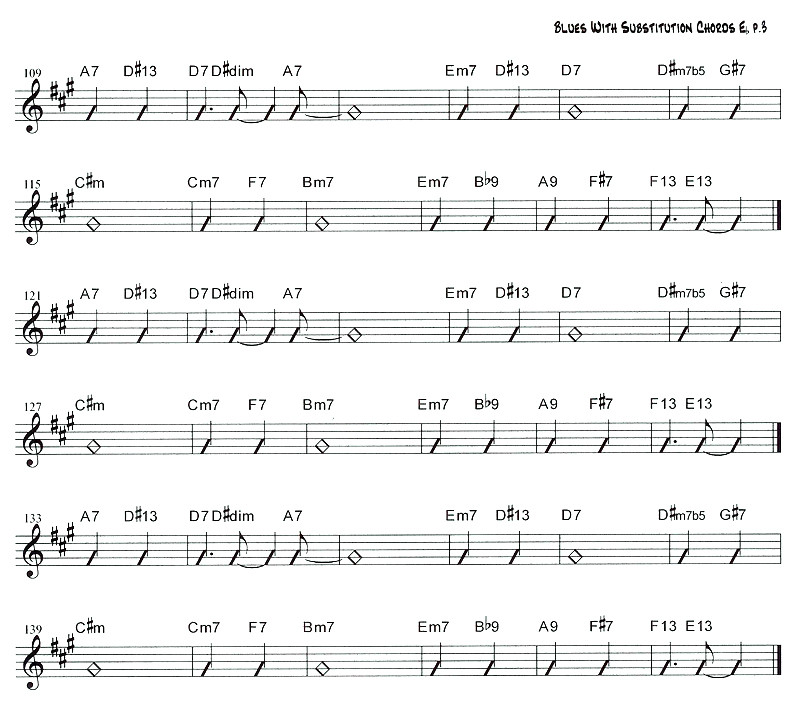
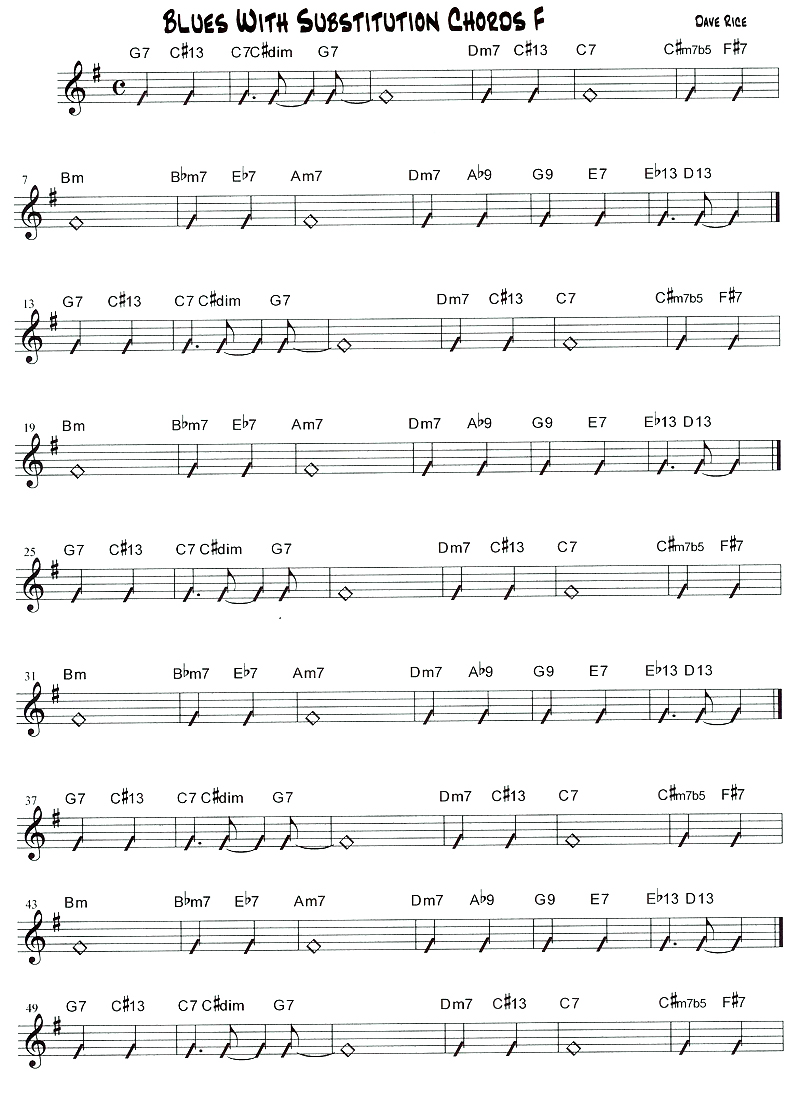
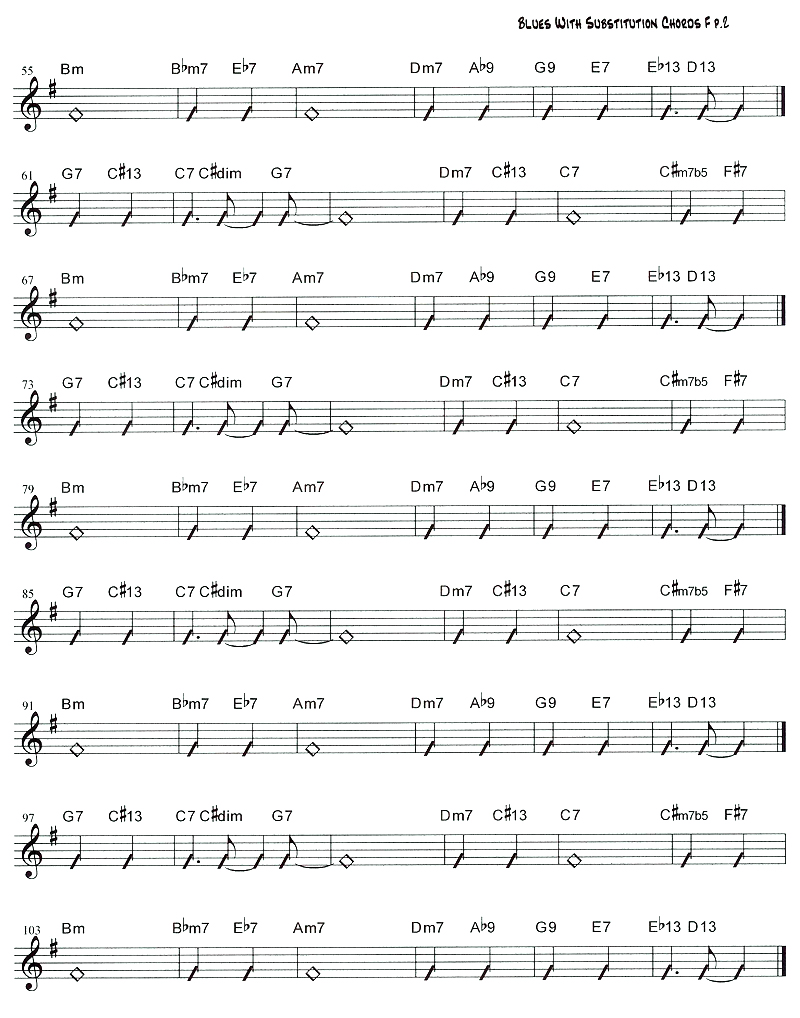
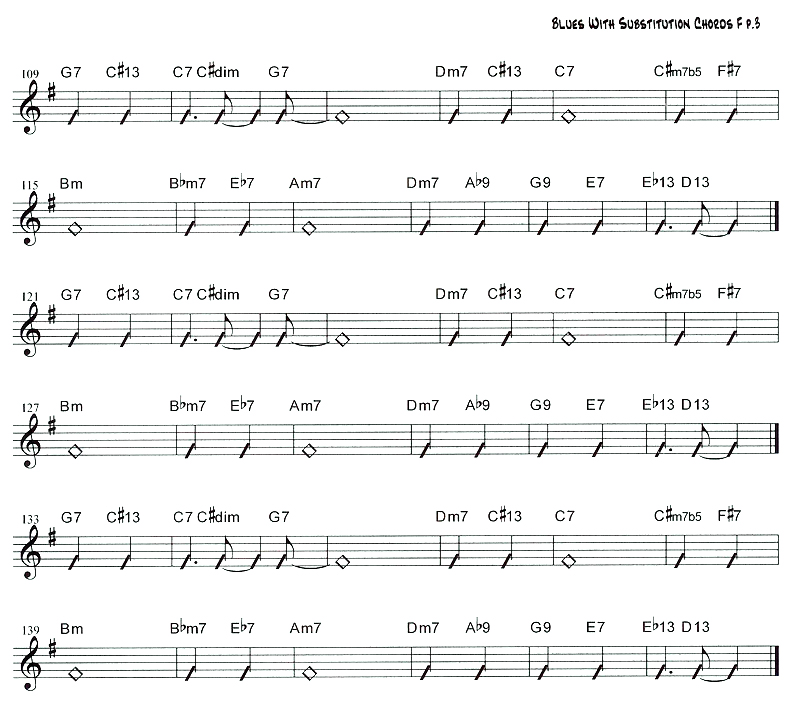
As you practice this progression remember that you have all of the resources from the ii-V7-I and iiÝ7-V7+-i library to choose from. You can utilize the modes, diminished scales, half diminished scales, altered scales, pentatonic scales in all the various positions.
The students who participated in the improvisation portion of my music program did so strictly on a volunteer basis. Our student population at R C Hill Elementary School is culturally diverse. We have a student population of approximately 45% Caucasian students, approximately 40% Hispanic students, less than 15% Polish, and less than 5% African-American. I meet with each class twice a week for 30 minutes. This method project has been in formation in the formal sense only since January 2008 which is when I began to post the section called jazz improvisation onto my website www.davericeproductions.com.
The practice of improvisation in my music class did not fit the pattern of a clinical experiment this past semester. Because this is a very recent addition to our daily classroom routine I offered those students who were genuinely interested in improvising a chance to practice soloing. Everyday I gave them the name of my website and encouraged them to go online and read the section entitled jazz improvisation. Although the website was not finished, it has been functional and running this past semester. Some students came back to class and told me they visited the website and even played along with the audio tracks.
I did not force any students to improvise. What I did offer is extra credit for those who would like to play an improvised solo over the most basic chord progression in our last song of the Spring concert. The simplest progression I could offer for students to improvise over is A minor7 to D. This only requires that students play an A dorian mode over this chord progression.
I took the names of those students who wanted to take a solo. Because we have a high percentage of Hispanic children I chose a well known song written by famous Afro-Cuban style composer Tito Puente. The song which was the finale to our spring concert was 'Oye Como Va'. If you are familiar with 'Oye Como Va', there is a long section in the middle where the rhythm section can vamp on Am7-D7 as long as the conductor permits. This was a perfect venue for the students to take a solo using the A dorian mode. They could make there solo as long or short as they wanted.
So, twice a week each 5th grade music class in our school practiced the melody of 'Oye Como Va' on recorders in preparation for the spring concert. I set up a microphone in the middle of the classroom for those students who volunteered to take a solo. The entire class practiced with me playing the A dorian mode on the recorder. Besides using recorders, I setup 2 keyboards so that those students who are studying piano could solo on the piano. I also purchased a set of congas and bongo drums for my class. Lastly, we had 3 dedicated 5th grade guitarists who brought there instruments to class to practice. Each person who volunteered to take a solo got to practice each period. The recorder players stood in line at the microphone and we practiced using good microphone technique. Each student usually took a solo for about 32 measures although I did not put a time limit on their solos.
We had a total of thirty two 5th graders and two 3rd graders who lined up to take solos. The two third graders were not practicing the dorian mode and played non-pitched percussion. Of the thirty two 5th graders, 3 played guitar, 3 played piano, one doubled on non-pitched percussion and the rest soloed on soprano recorder. My goal in introducing improvisation was not to collect data. This program is just starting this past semester and is not yet a formal part of our curriculum. Instead my goal has been to create the method of instruction and give the students an opportunity to learn the basic beginnings of improvisation and give them a chance to improvise over a short chord progression in a live situation.
In Valley view School district our music concerts which we have once a semester are very well attended. As a matter of fact more family members come to our elementary concerts than to any other event in the district other than perhaps the high school graduation. On June 6th, 2008 we set up our Spring Concert outdoors at R.C. Hill Elementary School. The local television station setup three television cameras and crew. Most of the faculty from R.C. Hill attended and assisted with lining up children, supervising, and helping them onto risers, etc. We hired two police officers to manage the audience which we estimated to be approximately 2200 people. Through the use of PTO funds I hired a professional guitar player, drummer, tenor saxophone player and trumpet player.
As we neared the end of our concert the soloists lined up. 3 students played percussion, 3 played guitar, 3 played piano and 23 lined up in two lines to play recorders over the microphones.
The band started 'Oye Como Va' as the closing piece in our concert. As we came to the solo section in the song the rhythm section played more quietly and each student had a spotlight section in front of the audience to solo using the A dorian mode. I was impressed by how well the students played and how many really thought out their solos which indicated they had spent real time practicing.
As I began my summer 2008 semester at Vandercook on June 16, 2008, the Romeoville Public Television Station was still editing the video from our spring concert at R.C. Hill. I am hoping they will have a DVD available for me by our poster night on July 16, 2008.
I started this project with a desire to create an educational website which was free to the viewer with audio exercises and easily accessible to all students as well as an educational booklet with CDs. Improvisation is not considered to be one of the prominent musical concerns in our curriculum. I hope to change that perspective. Having this website for that use makes this far easier.
It is definitely included in state and national standards. I can speak from personal experience when I say that the skill required to solo over chords and modes in a jazz or blues setting is a never ending discipline which requires more and more practice over time. I believe the program outlined in this study is one which may be implemented in the elementary grades and carried forward through junior high and high school.
In the future, I will continue to add to the website. The images of scales and progressions exercises for all instruments in concert, Bb, Eb, and F transposition already can be printed from the website by anyone with a printer and computer. I feel the next logical step would be to create a set of lesson plans that corresponds to the exercises and to add them to the website so they may be downloaded as well. In the future I would also like to add a section that explains the 'The Rhythm Changes' in all twelve keys.
I play piano professionally 4 or 5 nights per week. I use these same exercises to warm up before I play. I find them to be invaluable.
Mode. (n.d.) Retrieved January 21,2008, from Wikipedia: http://en.wikipedia.org/wiki/Musical_mode
Improvise. (n.d.) Retrieved July 11, 2008, from http://www.sibeliuseducation.com/pdfs/MENC_tables.pdf
Standards. (n.d.) Retrieved June 21,2008 from http://www.menc.org/publication/books/performance_standards/k-4.html
KodŠly, Z & KodŠly, Mrs.Z. (1974) "The Selected Writings of ZoltŠn KodŠly", Boosey & Hawkes Music Publishers Ltd. London WIA 1BR.
Landis, B.& Carder, P. (1972 ), "The
Eclectic Curriculum in American Music Education: Contributions of Dalcroze,
KodŠly, and Orff", Music Educators National
Conference 1201 Washington, D.C..
Levine, M. (1995). "The Jazz Theory Book", Sher Music Company., Petaluma, Ca.
Jarvis,J.& Beach, D.( 2002).
"The Jazz Educators Handbook". Kendor
Music, Inc. Delevan, N.Y.
Aebersold, J.(1967). "How To Play Jazz and Improvise", Jamey Aebersold Jazz, Inc. New Albany ,In.
Baker,D.(1968) "Jazz Improvisation", Alfred Publishing Co, Inc. Van Nuys, Ca.
Aebersold, J.(1979)."Turnarounds, Cycles & II/V7's for all instruments" . Jamey Aebersold Jazz, New Albany ,In.
Haerle, D.(1974). "Jazz/Rock voicings for the contemporary Keyboard Player", (Haerle,Dan, 1974) forward by Jerry Coker. Haestudio P/R, Inc.Lebanon, In. 46052.
Haerle, D, Coker, J. (1974)."Jazz/rock contemporary voicings for the contemporary keyboard player". Studio P/R,Inc. Lebanon, In.
Haerle, D, Coker, J. (1974) ďJazz Improvisation for Keyboard Players Complete EditionĒ. Alfred Publishing Co. Inc. Van Nuys, Ca.
Aebersold,
J(1974) The II-V7-I progression, the most important musical sequence in
jazz! Jamey Aebersold Jazz, New Albany ,In.
Aebersold,
J(1974) The II-V7-I progression, the most important musical sequence in
jazz![CD].
Jamey Aebersold Jazz, New Albany ,In.
Leibman,D
Observations on the blues as cited in
Aebersold, J(1981)Nothin'
but the blues.
Wickipedia Online Dictionary, keywords 'chord' July 1,2007.
The New Grove Dictionary of Music and Musicians Fifth Edition (2001)Volume 5 Canon-
Classic rock.
The New Grove Dictionary of Music and Musicians Fifth Edition (2001) Volume 7 Dŗn tranh -
EgŁťs, p. 442.
The New Grove Dictionary of Music and Musicians Fifth Edition (2001) Volume 7 Dŗn tranh -
EgŁťs, p. 351.
Singh, Vijay (2003). Where to Find Resources and Quality
Teaching Tools, Repertoire & standards: vocal jazz- advocacy for jazz
pedagogy p.47:Retieved from IIMP database 6/28/2007.
The New Grove Dictionary of Music and Musicians Fifth Edition (2001). Volume 3
Baxter-Borosini, p. 727.
Leonard, H. ( 1980)."How to improvise with piano". Hal Leonard publishing, Inc. and Yamaha
music foundation. Milwaukee, Wi.
LaPorta, J. ( 1972 ). A guide to jazz phrasing and interpretation. Berklee Press Publications.
High, J. (2005) Chords /scales and diagrammed approaches for improvisation. Authorhouse.
Blake,J, Jr.; Harmon, J.,Harmon,P. (1993), Jazz Improvisation Made Easy for Violin, Volume #1 Beginning to improvise. P.O.Box 186,301 Littleton Road, Westford, MA. 01886.
Azzara,C; Grunow, R; Edwin, G. (1997)Creativity in Improvisation. GIA publications, Inc.
Fitzgerald, M.; McCord, K.; Berg, S. (2003) Chop-Monster Jr.,jazz language tutor for general music instruction. Alfred Publishing Co. Inc. 16320 Roscoe Blvd., Suite 100 P.O. Box 10003 Van Nuys, Ca. 91410-0003.